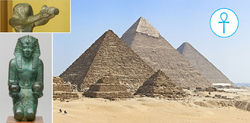- Retour accueil
- Vous êtes ici : Blog The Pyramids of the Cold The Pyramids of the Cold Section 27 • The Memphis Evaporative Cold Triad air inflated snake
The Pyramids of the Cold Section 27 • The Memphis Evaporative Cold Triad air inflated snake
Publié par Bruno Coursol dans The Pyramids of the Cold le 28/10/2022 à 10:14
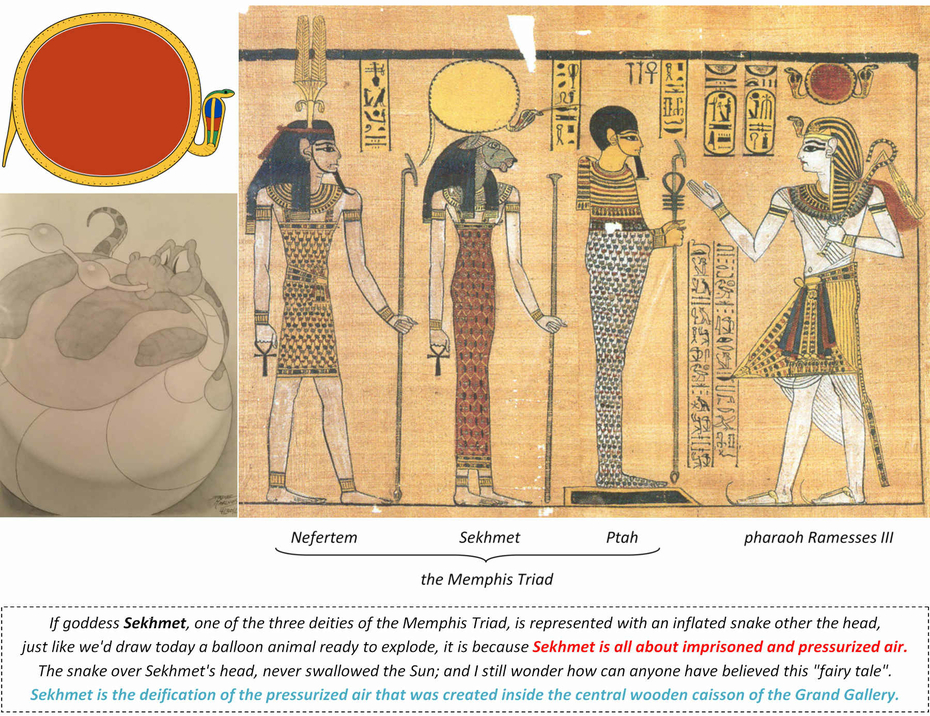
Memphis, literally "White Walls", was the first capital of Egypt following its unification by the pharaoh Menes. The people of Memphis believed that their god Ptah, at the heart of the Memphis Triad was the most ancient and pre-eminent of all the gods. Ptah was seen as the creator of all the other gods and he was called the "heart and tongue" of the Ennead.
Pharaoh Ramsses III (on the right) and the three gods of the Memphis Triad: Nefertem (on the left), Sekhmet (center) and Ptah, facing Ramesses III: https://commons.wikimedia.org/wiki/File:Ramses_III_and_the_Memphis_gods.jpg
The Pyramids of the Cold Section 27: the Memphis evaporative cold Triad air inflated snake
In summary : we've seen that the Great Pyramid of Egypt was meant to create evaporative cold using the power of water, and that there are a lot of elements supporting this idea in the internal layout of the pyramid itself, in particular regarding the massive girdle stones in which had been hollowed out the entire lower part of the "ascending passage" inclined well.
But evaporative cooling simply doesn't work if there is just creation of a fog of microdroplets of filtered water: you also need air, a lot of "fresh" dry air. Each and every cycle of the operation of the pyramid had to supply both water and air to the horizontal passage.
Unfortunately, because air is so easy to move, there isn't any element still in the pyramid that seems to have been involved in this matter: every part that supplied dry air to the cooling passage, was simply made out of wood and it have been removed at the end of the operating period of the pyramid, once the well has been drained.
But it doesn't mean there isn't any other way to start reconstructing that dry air supply system, because without a fixed wooden caisson, inside which the impactor would have been operated, and which would have been exactly extending the inclined well inside the Grand Gallery itself, no air at all would have been able to be used: the fall of the impactor absolutely had to happen in a closed structure to produce and use pressurized air.
We also know that this central wooden caisson had to have a hatch on its lower part so that one of the crewmembers of the Hauling beetle could reattach the impactor with its hauling rope after its fall. In this Section, we'll see that like every other part of the Great Pyramid's operation, this Hatch has been glorified into an ancient Egyptian deity: the cat goddess Bastet.
We'll also see that her counterpart sister Sekhmet is the representation of the pressurized air itself, and that when Bastet was holding the pressure inside the caisson, some air would eventually be able to pass through the seals of the Hatch, making the air hiss and whistle, and the Hatch itself to vibrate, explaining why Bastet is often represented holding a sistrum musical instrument.
Bastet's sistrum is about the whistling air just like the Isis and Nephthys Lamentations are about the squeaking noises that ropes are making under tension (and the water dropping from the wet ropes).
Also we'll see that Hathor was the glorification of the Hauling beetle, at the end of its operating cycle, when the structure would have reached back the top of the Grand Gallery after its job had been done. When Hathor is holding a sistrum, it is this time about the noise and agitation that occurred at this very special moment of the operating cycle, in particular it is then that the crewmembers shift change would have been done, resulting in what could be described as the "total chaos" side of goddess Hathor.
Finally we'll see that the Memphis Triad, which is gathering Sekhmet, Ptah and Nefertem deities, is simply summarizing the production of the evaporative cold by associating pressurized air (Sekhmet), with pressurized water (Ptah) and the fog nozzle (Nefertem). Ptah was the deification of the inclined well of the Great Pyramid which functioned like a living and functioning heart, and Ptah was indeed described as "the heart of the Ennead".
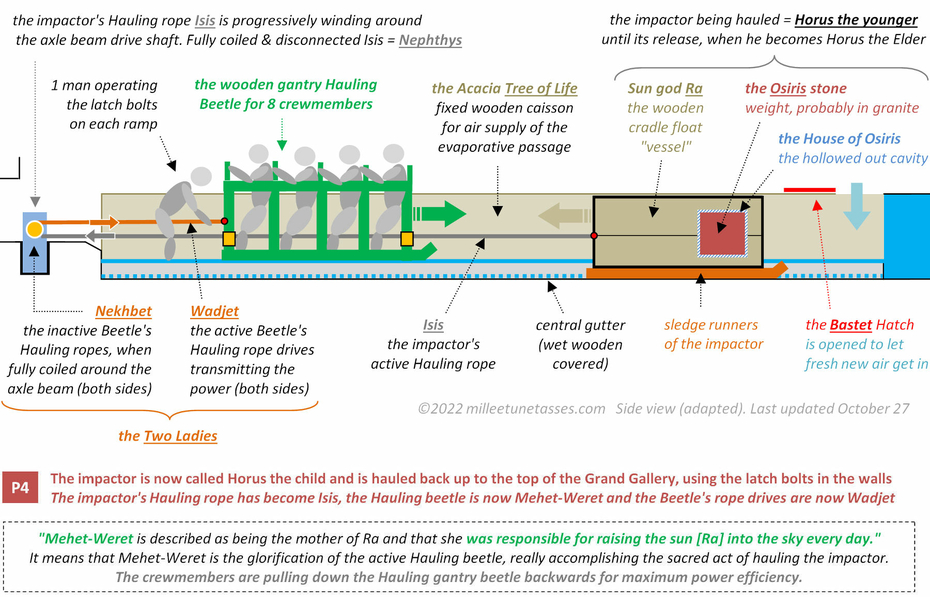
The crewmembers are pulling down the Hauling gantry beetle backwards for maximum power efficiency. Of course, the impactor couldn't be seen inside the central wooden caisson; and the Hauling beetle is actually totally covering the caisson on both sides as well as on top: the central caisson also disappear completely underneath the Hauling beetle.
27.01 The operating cycle of the Grand Gallery (side view): Position 4
• The impactor is now called Horus the child and is hauled back up to the top of the Grand Gallery, using the latch bolts in the walls
The impactor's Hauling rope has become Isis, the Hauling beetle is now Mehet-Weret and the Beetle's rope drives are now Wadjet.
27.02 The Great "inert", "asleep" and "lethargic" Osiris... but who gives all his "force", "power" and "energy" to Ra
The fact that Osiris is nothing but the glorification of what was the weight of the impactor, its ballast so to speak, is actually perfectly explaining one of his epithets: Osiris was seen as the "Great inert".
Also, another name of Osiris is Wenennefer, which means "the one that remains perfect", and it probably is referring to the fact that the Osiris stone was hidden and fully protected inside the wooden impactor.
About Osiris' epithets: "The egyptologist W. Budge counts no less than forty of them. The Egyptians, always obsessed by their desire to reject death by any means, use metaphors or more or less explicit circumlacation to speak of Osiris and his state.
The various Books of the Dead teem with them. One notices that the God never dead, he is asleep, he is apathetic, he is lethargic, etc. Here are some examples: "the great inert", "the king of those who are not", "the Lord of the living", "the master of eternity", "the one who governs Ro-Setau", "the first of the westerners".
As Wenennefer, which means "the one that remains perfect" […]." https://www.osirisnet.net/dieux/osiris/e_osiris_01.htm
I need to point out that this "inert", "asleep" and "lethargic" Osiris, is the exact same one than the Osiris who is giving all his force, all his power and all his "ramming" energy to Ra:
"Ra at this time becomes merged with Osiris, the judge of the dead, and Osiris is seen as the “corpse” and Ra as the “soul” of the single deity Ra-Osiris." https://www.worldhistory.org/Ra_(Egyptian_God)/
"Osiris' soul, or rather his Ba, was occasionally worshipped in its own right, almost as if it were a distinct god […] This aspect of Osiris was referred to as Banebdjedet. […] As Banebdjed, Osiris was given epithets such as Lord of the Sky and Life of the (sun god) Ra. Ba does not mean "soul" in the western sense, and has to do with power, reputation, force of character, especially in the case of a god. […] Since the ba was associated with power, and also happened to be a word for ram in Egyptian, Banebdjed was depicted as a ram, or as Ram-headed." https://en.wikipedia.org/wiki/Osiris (in the "Ram god" section).
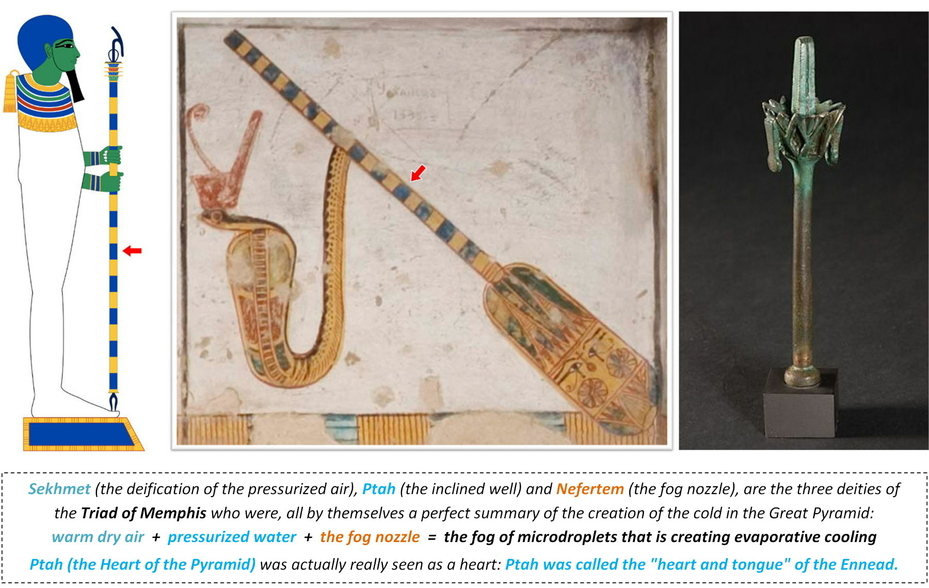
"Ptah, in the form of a mummified man (except for arms and face) standing on the symbol for Ma'at, holding a scepter or staff that bears the combined ankh-djed-was symbols" and drawing of the Creation god Ptah by Jeff Dahl on Wikipedia: https://en.wikipedia.org/wiki/Ptah
Photograph from tomb KV 11 of Ramesses III, side chamber, image # 21076 by Matjaz Kacicnik, courtesy of ARCE, American Research Center in Egypt in partnership with the American University in Cairo Egyptology Department: https://thebanmappingproject.com/images/21076jpg
Nefertem Emblem, inventory number N 5118 © Musée du Louvre / Christian Décamps: https://collections.louvre.fr/ark:/53355/cl010008518
27.03 The 1st deity of the Memphis Triad is Ptah: the representation of the inclined well of the Great Pyramid of Egypt. It is known that Ptah was seen as a living and functioning "heart"... just like the inclined well was the Heart of the Great Pyramid
We've already seen in previous Sections that if ancient Egyptians were so obsessed about the Heart, it was only because the inclined well of the Great Pyramid, which is today called "(first) ascending passage", was seen as a living and functioning heart, pressurizing water and ejecting, or "spiting" some of it through the Junction imprint into the evaporative cooling passage. We've also seen that this well has been glorified and deified into god Ptah, one of the three deities of the Memphis Triad.
It is then not a surprise to read in the following excerpt, that Ptah was indeed seen as the "heart and tongue" of the Ennead: the heart and tongue metaphors are about pressurizing water and spiting droplets of that water.
"The people of Memphis believed that their god Ptah was the most ancient and pre-eminent of all the gods. Ptah was seen as the creator of all the other gods […] He was called the "heart and tongue" of the Ennead." http://www.egyptianmyths.net/memphis.htm
"During the Old Kingdom, Memphis became the capital of Ancient Egypt for more than eight consecutive dynasties. The city reached a peak of prestige under the Sixth Dynasty as a centre for the worship of Ptah, the god of creation and artworks. The alabaster sphinx that guards the Temple of Ptah serves as a memorial of the city's former power and prestige. The Memphis triad, consisting of the creator god Ptah, his consort Sekhmet, and their son Nefertem, formed the main focus of worship in the city." https://en.wikipedia.org/wiki/Memphis,_Egypt#:~:text=The%20Memphis%20triad%2C%20consisting%20of,of%20worship%20in%20the%20city
27.04 Ptah's plastered blue hair and the bandage constraints
We've seen that if Ptah has been seen as the god of craftsmen, it is because of the extreme complexity of the inclined well layout, including the massive face to face girdle stones of its lower part, the three massive granite blocks (the granite "plugs"), including the Taweret block and its wedging block Bes, but also the very elaborate polygonal arrangements of the other blocks, in a very intricate and complex way.
The representations of Ptah are fascinating, because they are perfectly showing some of the most important characteristics of what Ptah is really all about: the inclined well of the Great Pyramid.
• First: his hair is both painted in a vivid water blue color, and appears plastered like if he was getting out of a swim
• Second: Ptah is represented mummified just like Osiris, and for the exact same reason. The bandages in which Osiris is wrapped into in so many representations, are both metaphorical and very real: the Osiris stone was most probably completely wrapped in tissue or linen so that she didn't move a fraction of an inch inside the hollowed out cavity of the wooden cradle of the impactor.
But from the outside, it would have looked like Osiris was constraint not by the wooden cradle, but by the bandages themselves.
When Ptah is represented mummified, it is for the exact same reason: the constraint; even if this time it is Ptah himself (as the inclined well), who is responsible for the constraint. It is the inclined well which is resisting the pressure when the impactor rams into its waters. Ptah is the one who is performing the restraint.
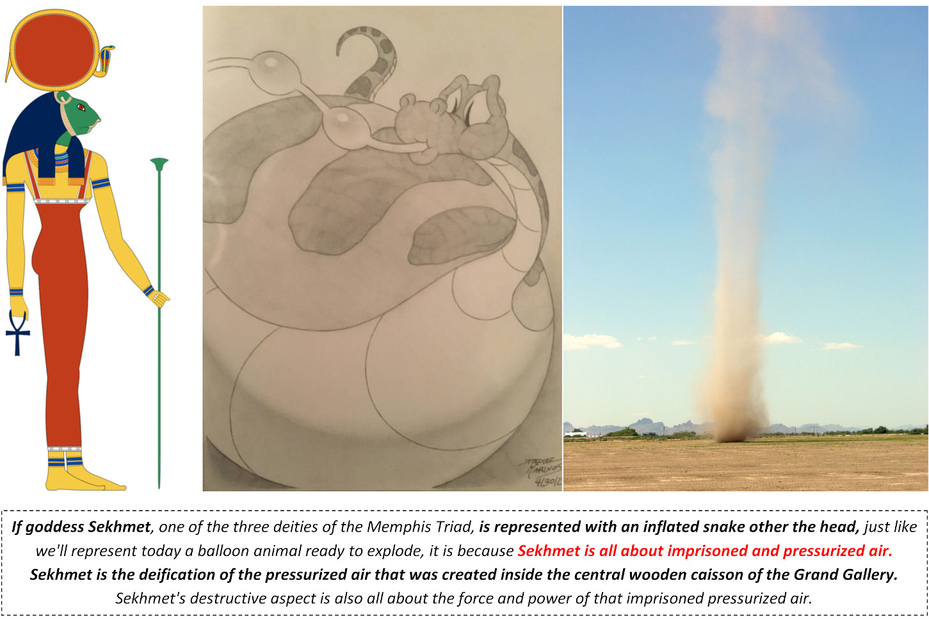
Draw of goddess Sekhmet by Jeff Dahl: https://en.wikipedia.org/wiki/Sekhmet
Snake Inflation by DoodleDan86: https://www.deviantart.com/doodledan86/art/Snake-Inflation-Pencil-Drawing-2015-788697049
A dust devil in Arizona: https://www.nasa.gov/images/content/122739main_dust_devil_june_10.jpg
27.05 The 2nd deity of the Memphis Triad is Sekhmet: the deification of air being compressed and pressurized inside the central caisson of the Gallery, before being ejected from it towards the evaporative cooling passage
The most important thing about Sekhmet's representations is the emblem she has over the head, the one described by egyptologists as one of many representations of the Sun.
In fact, it is pretty simple: every time there is a disc in ancient Egyptian art, it has to be about the Sun, or sometimes about the moon; and every time, there will be a plausible explanation for it. I have no doubt that here again, egyptologists came up with another explanation for the "Sun inside the snake" representation.
Egyptologists seem to think that everything about ancient Egyptian art and religion has to be taken literally, and that is the most profound mistake. This is a mistake which started with the very first attempts to decipher ancient Egypt in the early 1800's, and it is tremendously damaging for the comprehension of this ancient civilization, because everything has to be taken metaphorically: the art, the myths and the gods.
The metaphor about the inflated snake of Sekhmet's emblem, is actually so "modern" so to speak, that I'm wondering why nobody has already deciphered it, because we've all seen this metaphor hundreds of times in cartoons: it is just a balloon animal, who is ready to explode because there is too much air inside him.
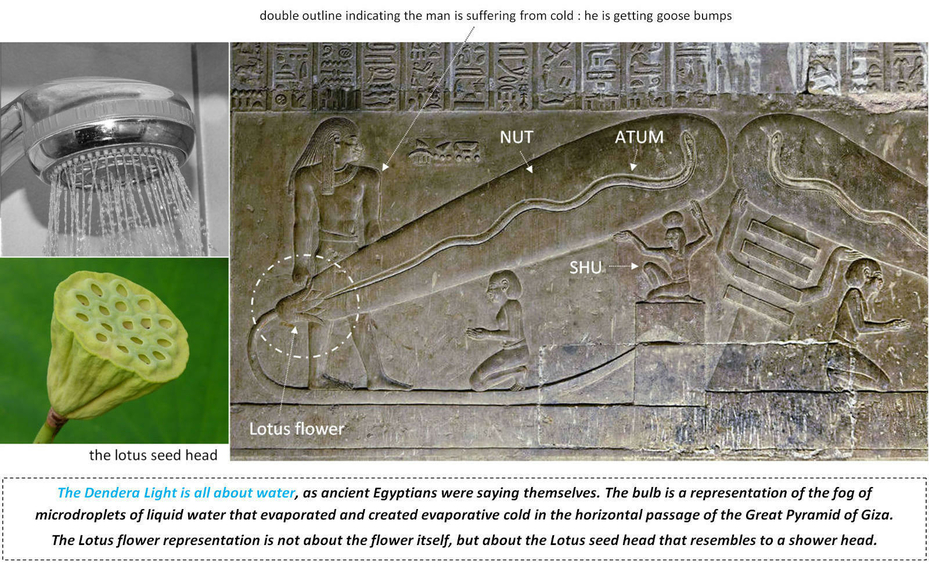
The fact that the Dendera Light is made of liquid water that transforms itself in a magical way, is exactly what are describing ancient Egyptians themselves : [About the snake inside the Dendera Light Bulb] "The field surrounding Ra’s snake form is referred to in ancient Egyptian literature as protective magical energy in liquid form that all gods and pharaohs possess (Faulkner 1970*)." https://ahotcupofjoe.net/2016/11/dendera-light-bulb-and-bagdad-battery-nonsense/
*I'm not sure, but the excerpt might be from "The ancient Egyptian book of the dead / translated by Raymond O. Faulkner ; edited by Carol Andrews, 1972."
The Dendera Light relief in the Hathor temple, photographed by Kairoinfo4U and posted on flickr: https://www.flickr.com/photos/manna4u/14525094039/in/photostream/
Lotus seed head image thanks to Dinkum: https://commons.wikimedia.org/wiki/File:Nelumbo_nucifera_%28fruit%29.JPG
27.06 The third deity of the Memphis Triad is Nefertem: the glorification of the fog nozzle of the Great Pyramid, and who had been described as "the beautiful One who closes" or "One who does not close"
The emblem of Nefertem is the lotus flower, but like everything else, the flower is just another metaphor: it isn't the flower in which ancient Egyptians were interested in, it is the lotus seed head that resembles to a shower head and which has been used to represent the functioning of the fog nozzle; and because the functioning of the fog nozzle wasn't continuous, but on the contrary based on a sequential process because of the Hauling cycle that could have been taken about 15 minutes, maybe a little more, Nefertem was described as "the beautiful One who closes" or "One who does not close".
"Close or not close" is not a bad epithet for what was really representing Nefertem: the fog nozzle of the horizontal cooling passage was actually nothing else than a huge water tap that transformed pressurized water from the inclined well (the "primal waters") into a mist of microdroplets of liquid water. There was no valve though, just the fall of the impactor inside the grand gallery of the Great Pyramid that turned the nozzle on, every 15 minutes and for maybe just a few seconds.
From Wikipedia: "Nefertem, possibly "beautiful one who closes" or "one who does not close", (also spelled Nefertum or Nefer-temu) was, in Egyptian mythology, originally a lotus flower at the creation of the world, who had arisen from the primal waters". https://en.wikipedia.org/wiki/Nefertem
On the so famous reliefs of Dendera showing the Dendera lights, what has been described as a "womb" or as "real electric lamps" by some people, is actually the fog of microdroplets after the pressurized water has come through the fog nozzle (please, read Section 2 for more on the Dendera lights).
Nefertem is the metaphoric representation of the fog nozzle; i.e. the deification of the lotus seed head.

27.07 The combined deities of the Memphis Triad are like a perfect metaphoric diagram of evaporative cold production
To summarize the evaporative cooling process, you only need three elements:
1 • the pressurized water that is gonna be transformed into the fog of microdroplets, and which is coming from the inclined well, deified into Ptah (the god of craftsmen)
2 • the pressurized air that would renew the moist air of the previous cycle in the evaporative passage, and which had been deified into goddess Sekhmet
3 • the fog nozzle which is the one mixing them both and producing the fog, and which had been deified into Nefertem (the god of the "Lotus flower")
In other words, the Memphis Triad, by associating Ptah, Sekhmet and Nefertem, is the glorification of the "experimental" approach of the evaporative cooling process.
Original image of Rameses II flanked by Ptah (left) and Sekhmet (right), as a representation of the Memphis Triad (Sekhmet + Ptah + Nefertem), thanks to Daniel Mayer: https://commons.wikimedia.org/wiki/File:Egyptian_Museum_-_Statue_in_front_of_trio_of_figures.JPG
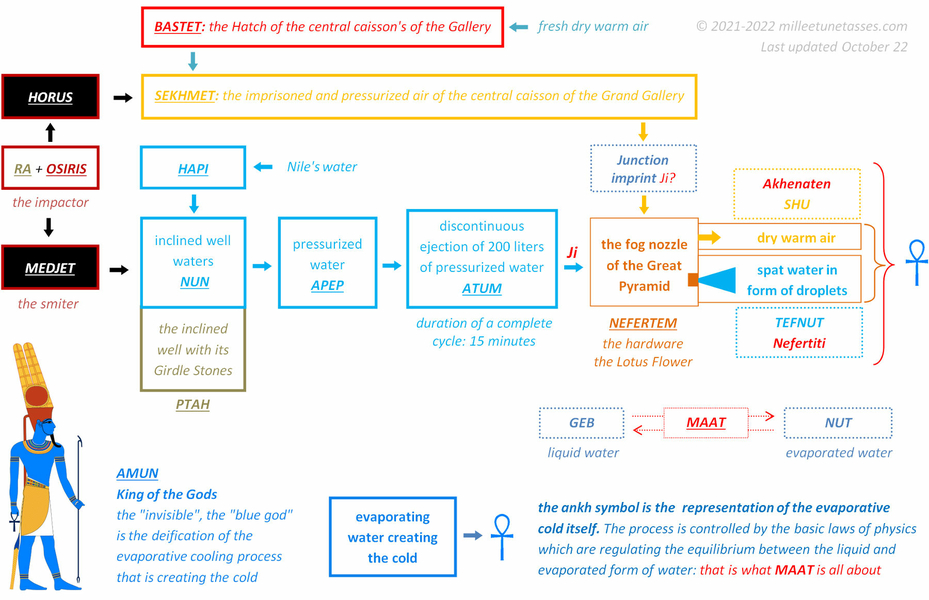
27.08 The real family tree of some of the major ancient Egyptian deities
The ankh symbol is the representation of the evaporative cold itself. The process is controlled by the basic laws of physics which are regulating the equilibrium between the liquid and evaporated form of water: that is what Maat is all about.
27.09 The "masturbatory Hand of Atum" is the Hauling beetle, endlessly moving up and down the Grand Gallery, with the impactor constantly "penetrating its body"
What is extraordinary with ancient Egyptians is that they didn't seem to have any difficulty using sexual metaphors when it was necessary; and of course, the ejection of a small amount of pressurized water from the well and the endless criss-cross movements of the impactor within the Hauling beetle structure gave them the opportunity to play with such metaphoric representations: whether we are talking about the endless up and down "sliding and penetrating movements" of the Beetle in the Gallery, or about masturbation and intercourse, they all end up with some kind of "ejaculation" of pressurized liquid.
We've already seen that Atum was precisely the representation of this small amount of water that was endlessly produced by the fall of the impactor. It could have been about 200 liters of pressurized water that would have been transformed into a fog of microdroplets, every 15 minutes or so.
We've also seen in previous Section 26.25 that the biosand filter Sarcophagus was indeed able to supply precisely this amount of water, with its 1.3464 m² of internal surface: in theory, the Sarcophagus could have been able to supply 201.96 liters of filtered water every 15 minutes.
So if Atum is the representation of these 201.96 liters of pressurized filtered water, and that the "Creation" process is about the production of the evaporative cold, then the description of Atum masturbating whit his Hand, is all about what produced this pressurized water: the Hand of Atum is the Hauling beetle, endlessly moving up and down the Grand Gallery of the Great Pyramid.
"The process of creation was said to have begun when Atum masturbated, or copulated with himself, to produce the deities Shu and Tefnut, thus beginning the process of creation. The hand he used in this act was personified as a goddess, the Hand of Atum. She (the Hand), was equated with Hathor or Iusaaset and Nebethetepet, two other, more minor goddesses. The earliest texts to mention them seem to treat Iusaaset and Nebethetepet as two names for a single goddess, but after the time of the Middle Kingdom (c. 2000–1700 BC) they were treated as separate, although similar, deities. The name "Iusaaset" means something resembling "She who grows as she comes" and "Nebethetepet" means "Lady of the Field of Offerings'" https://en.wikipedia.org/wiki/Iusaaset
27.10 Hathor, Nebethetepet and Iusaaset are all "masturbatory Hands of Atum" and they all are deifications of the Beetle
The above excerpt is also telling is that the Hand of Atum has been represented into three goddesses: Nebethetepet, Iusaaset and Hathor. It means that the three of them are representations of the Hauling beetle. Just like for the ropes of the Gallery, ancient Egyptians didn't just represent the Beetle in one deity, they've represented it in many ways, depending on its position in the Gallery, and its different aspects: its wooden structure or its endless up and down movement in the Gallery.
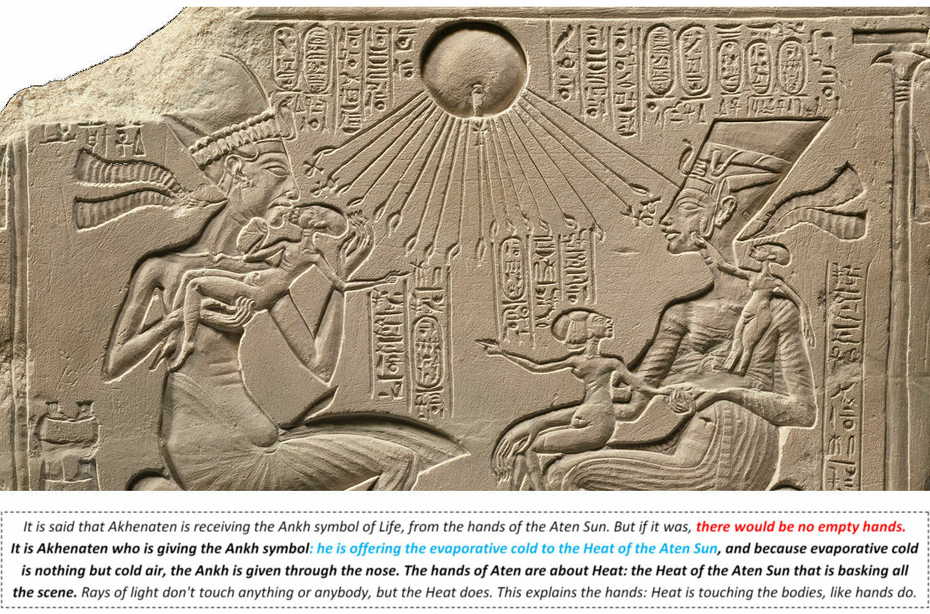
House altar: Akhenaten, Nefertiti and three of their daughters under the Radiant Aton. State Museums in Berlin, Egyptian Museum and Papyrus Collection / Margarete Büsing: https://recherche.smb.museum/detail/607132
27.11 The Memphis Triad vs. Akhenaten's divine Triad
The Memphis Triad deciphering is also precious for a better understanding of what really wanted to achieve the heretic pharaoh Akhenaten: by replacing the Memphis Triad which was all about the glorification of the experimental accomplishments in the Great Pyramid, with his own divine Triad with Nefertiti and the Aten, Akhenaten wanted to transform the experimental glorification of the evaporative cooling into a more theoretical glorification of the process.
Akhenaten represented himself into Shu (the god of dry and warm air), while Nefertiti represented herself into Tefnut (the goddess of water in spat form, as 'tef' means 'to spit').
The most important thing, though is that they still worshiped the creation of the cold; and it is this cold that they offer to the Aten Sun, who by the way is just here to represent Heat, and nothing else: ancient Egyptians didn't really care about the Sun, nor they really cared about scarabs, falcons, cats, hippopotamus, snakes, bulls, cows, crocodiles, etc. The Sun and all these animals were only metaphors.
27.12 The theorization of the evaporative cooling process attempt by Akhenaten and Nefertiti
What Akhenaten and Nefertiti had really done, is stop worshiping the original "experimental approach" of the creation of the cold, instead they used the "theoretical approach" by worshiping Shu (Akhenaten represented himself into the god of dry and warm air Shu), and Tefnut (Nefertiti represented herself into the goddess of water in a spat form, Tefnut).
"During the “Aten heresy” led by Akhenaten, Shu, and Tefnut remained popular with the apparently monotheistic pharaoh. The pharaoh and his queen (Nefertiti) were depicted as the personification of Shu and Tefnut emphasising their divinity. As the Aten represented the sun disk, the solar aspect of Shu and his link with the pharaoh apparently prevented Shu from being proscribed along with Amun and the other gods." https://ancientegyptonline.co.uk/shu/
"Even on the pharaoh's own stone sarcophagus, images of Nefertiti replaced those of traditional goddesses. Akhenaten, by associating himself with Shu and the Aten, and Nefertiti with Tefnut, had effectively presented himself and his family as living gods." https://www.worldhistory.org/article/1110/the-art-of-the-amarna-period/
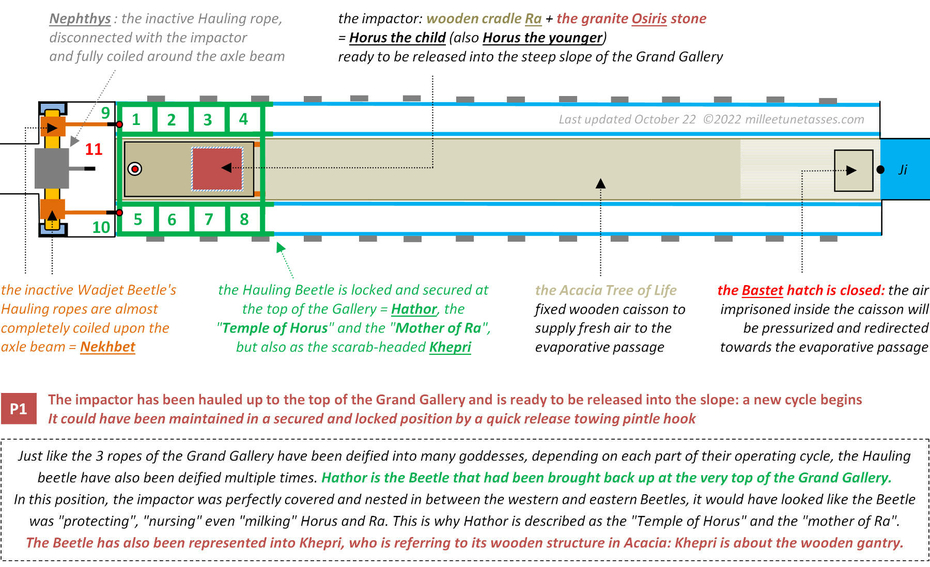
Of course, the impactor couldn't be seen inside the central wooden caisson; and the Hauling beetle is actually totally covering the caisson on both sides as well as on top: the central caisson also disappear completely underneath the Hauling beetle.
27.13 The operating cycle of the Grand Gallery • Position 1
• The impactor has been hauled up to the top of the Grand Gallery and is ready to be released: a new cycle begins
Just like the 3 ropes of the Grand Gallery have been deified into many goddesses, depending on each part of their operating cycle, the Hauling beetle have also been deified multiple times. Hathor is the Beetle that had been brought back up at the very top of the Grand Gallery. In this position, the impactor was perfectly covered and nested in between the western and eastern Beetles, it would have looked like the Beetle was "protecting", "nursing" even "milking" Horus and Ra. This is why Hathor is described as the "Temple of Horus", "House of Horus" and the "Mother of Ra".
"Hathor (Ancient Egyptian: ḥwt-ḥr, lit. 'House of Horus', A) was a major goddess in ancient Egyptian religion who played a wide variety of roles. As a sky deity, she was the mother or consort of the sky god Horus and the sun god Ra." https://en.wikipedia.org/wiki/Hathor
The Beetle has also been represented into Khepri, who is referring to its wooden structure in Acacia: Khepri is about the wooden gantry.
27.14 Bastet was only opened to reconnect the Isis rope with the floating impactor
Everyone knows Isis, but it is not even close to be the real name of the goddess, because it is a Greek name.
Ancient Egyptian name for Isis, is Aset; and what is very interesting is that Bastet is actually named after her: Bastet means the Ba of Aset. But it is most of all saying that the two of them, Isis and Bastet had a very close connection; and that connection is that the Bastet Hatch was only opened so that the Isis impactor's Hauling rope could have been reattached to the impactor floating in the well.
"The Greeks […] called the goddess […] Bast ba'Aset (Soul of Isis) which would be the literal translation of her name with the addition of the second 'T' to denote the feminine (Aset being among the Egyptian names for Isis*). https://www.worldhistory.org/Bastet/
*Isis is actually a Greek name for the Egyptian goddess Aset
27.15 Is Bastet's mouth the missing mouth of Medjed?
We've seen in previous Section 26 about the smiter deity called Medjed, that if both his nose and mouth were invisible, it was because Medjed represents the impactor, hidden inside the central wooden caisson, and I've associated Medjed's missing mouth with the mouth of the well; but maybe it was not the well's mouth, but Bastet's mouth instead.
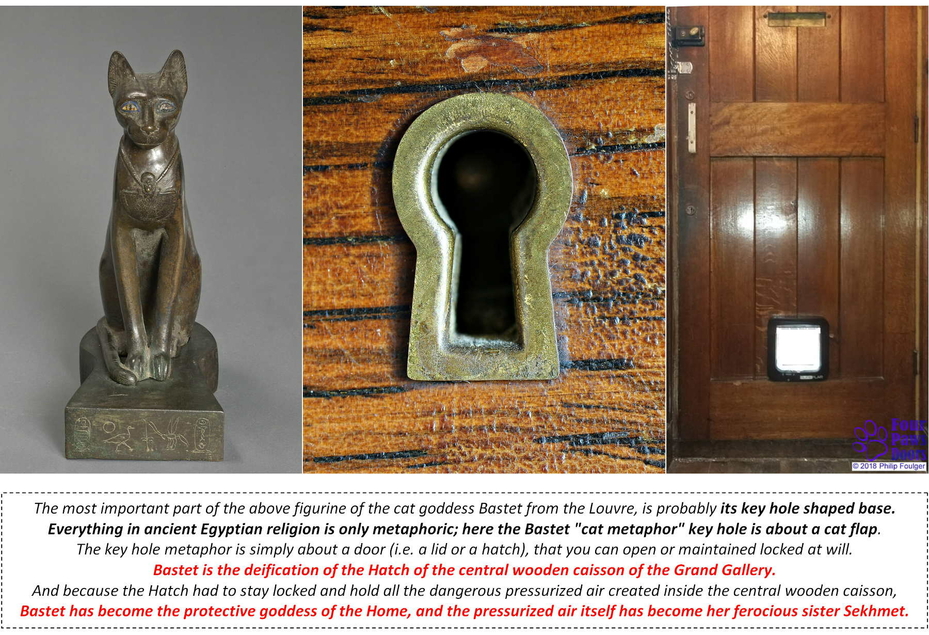
The key hole shaped base of the figurine from the Louvre, is the key, so to speak; because a key hole is probably the best metaphor that ancient Egyptians could have used to emphasize the fact that a door, or a hatch would have to stay closed, no matter what. Because of this key hole and the cat flap metaphor, we can assume that Bastet is about a closed hatch that stays closed, no matter what.
Figurine of the cat goddess Bastet, Musée du Louvre / Christian Décamps: https://collections.louvre.fr/ark:/53355/cl010006514#
A traditional keyhole for a warded lock, thanks to Thegreenj: https://en.wikipedia.org/wiki/Lock_and_key#/media/File:Wardedlock.jpg
27.16 Cat representations of Bastet are about the cat door: the cat metaphor is about a cat flap "hatch"
We've just seen who really was representing the destructive lioness goddess Sekhmet, now we are gonna find out about her gentle sister, the cat goddess Bastet.
It is well documented that both Sekhmet and Bastet are two sides of the same goddess; but this isn't right: they are not exactly about the same thing. But the confusion is understandable, because they actually really are indissociable.
To be more exact, Sekhmet cannot exist without Bastet, because Bastet was the deification of the Hatch of the central wooden caisson of the Grand Gallery. Bastet let the fresh new air get inside the caisson, and once the impactor had been released, Bastet is also the one who forced the pressurized air Sekhmet, to stay inside the caisson.
Bastet is the Hatch of the caisson, hence she has been seen as a cat door, and she has been glorified into a cat goddess. The cat metaphor is about a cat flap.
I've read a couple times people trying to explain that if ancient Egyptians worshiped cats as protectors of their homes, it was because "cats really protected homes from snakes, mice, of other rodents", but seriously did anyone ever get a cat thinking about protecting his home?
From personal experience, the only one thing that a cat is really doing, is killing everything he can outside the house, like birds, mice and rabbits and then get them back to you right at the entry of the house.
Ancient Egyptians only worshiped cats because of the Great Pyramid: the central caisson's Hatch controlled the entry of the air, and prevented it from getting out. The cat worship is about protecting your home, because it was the function of the caisson's Hatch.
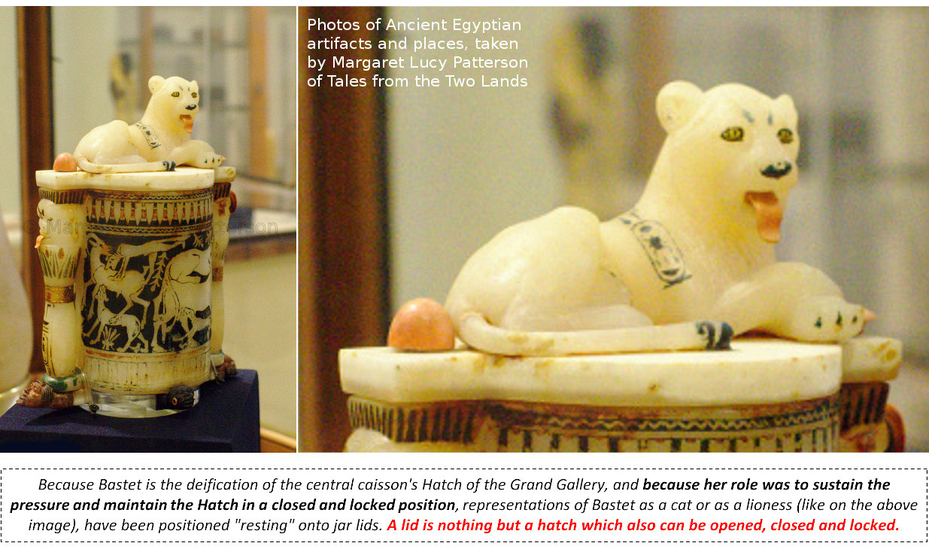
The Museum of Egyptian Antiquities in Tahrir Square Cairo (visited October 2016). Cosmetic Jar with Lions, Hunting Scenes and Captives; from KV62, Valley of the Kings. New Kingdom, Dynasty 18, reign of Tutankhamun, c. 1334-1325 BCE. Acc. No.: JE62119. Photos of Ancient Egyptian artifacts and places, taken by Margaret Lucy Patterson of Tales from the Two Lands: https://photos.talesfromthetwolands.org/picture.php?/625/categories
27.17 The lid of Tutankhamun's alabaster cosmetic jar is just another locked hatch
This metaphoric glorification of Bastet, as the representation of a closed hatch, has been used on the above alabaster cosmetic jar from the tomb of Tutankhamun: the lioness Bastet, is represented resting onto the lid of the jar, because the lid is nothing else that a special kind of hatch.
Ancient Egyptians loved to show what they did, but they hid everything underneath metaphors and tortuous mind games on the construction of the scenes they were representing.
For example, we've already seen that there is no such a thing as "the barque of Ra": Ra is the barque; Ra is the wooden part of the impactor.
The same way, there is no such a thing as the lioness goddess Bastet standing on the lid of the alabaster jar: Bastet is the lid, because Bastet is the Hatch.
27.18 The "Soul of Isis" goddess Bastet
The understanding of Bastet have been particularly difficult, because it first implied that was assumed as certain that the central wooden caisson of the Grand Gallery was a real thing, even if there is no remaining trace of it, and second because the metaphor used by ancient Egyptians about the cat was somehow unexpected: the cat metaphor of goddess Bastet is not really about the cat herself, but the litle door "hatch" that a cat is using to pass through the door of your home.
The cat metaphor is about a cat flap, or a cat door as you wish. Of course it is not really about the door of a home, the cat metaphor is about a hatch, the very one which had to be installed at the bottom of the central wooden caisson, so that the impactor could have been reconnected to its hauling rope once it was floating inside the inclined well after the impact with its waters.
In other words, it means that the cat goddess Bastet is the deification of that Hatch.
"Bastet is the Egyptian goddess of the home, domesticity, women's secrets, cats, fertility, and childbirth. She protected the home from evil spirits and disease, especially diseases associated with women and children. As with many deities in Egyptian religion, she also played a role in the afterlife. […] She is sometimes depicted as a guide and helper to the dead although this was not one of her primary duties. She was the daughter of the sun god Ra and is associated with the concept of the Eye of Ra (the all-seeing eye) and the Distant Goddess (a female deity who leaves Ra and returns to bring transformation). Bastet was one of the most popular deities of ancient Egypt as she was the protector of everyone's home and family." https://www.worldhistory.org/Bastet/
Bastet was the sister of Sekhmet, the wife of Ptah, and one of the most popular deities of ancient Egypt as she was the protector of everyone's home and family" https://egyptianmuseum.org/deities-Bastet
"Sekhmet was depicted with the body of a woman with a lion head wearing a sun disk. She was seen as the protector of the pharaohs and led them in warfare. When she was in a calmer state she would take the form of the household cat goddess Bastet. https://egyptianmuseum.org/deities-sekhmet
"The Greeks […] called the goddess […] Bast ba'Aset (Soul of Isis) which would be the literal translation of her name with the addition of the second 'T' to denote the feminine (Aset being among the Egyptian names for Isis*). https://www.worldhistory.org/Bastet/
*Isis is actually a Greek name for the Egyptian goddess Aset
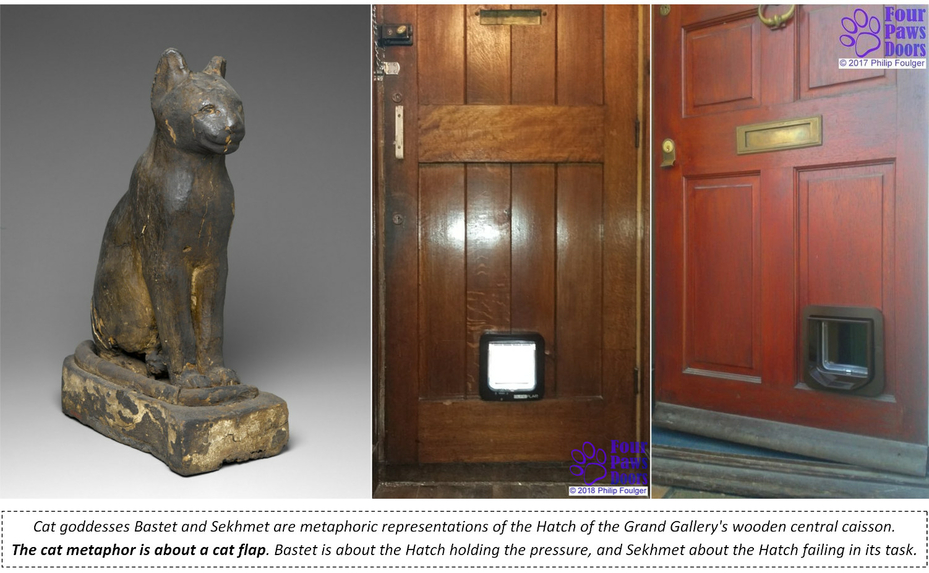
Wooden coffin for a cat shaped as a cat, from the Brooklyn Museum. "It is made from several pieces of wood, joined with wooden dowels. The main joins appear to run lengthwise in the center of the coffin, splitting the coffin into two halves. A cat mummy was inserted inside, the coffin assembled and then the gesso and layer of dark material (paint?) was applied, affectively sealing the wood assembly seams. The coffin was constructed to be inserted into a wooden base. The base is made from a single piece of wood and has hollow areas carved out to accept the mortise like joins at the undersides of the feet at both the front and rear of the cat. The tail of the cat is carved from three pieces of wood that have been doweled into the top of the base. In looking at the x-radiographs taken, the mummy inside appears to have the cat positioned so that the front legs are up and bent as opposed to long and crossed over the body as is seen on other cat mummies. On the coffin, there is a roughened depression at the top of this cat's head." https://www.brooklynmuseum.org/opencollection/objects/118450
Cat flaps from Four Paws Doors: http://www.fourpawsdoors.co.uk/jobs-in-2017---2018.html
27.19 The wooden coffin shape as a cat from the Brooklyn Museum
The wooden coffin for a cat shaped as a cat, from the Brooklyn Museum (above image), is a perfect illustration of the real meaning of the cat in ancient Egyptian religion: "It is made from several pieces of wood, joined with wooden dowels. The main joins appear to run lengthwise in the center of the coffin, splitting the coffin into two halves".
The structure of the coffin is probably mimicking the structure of the original central wooden caisson itself and it is possible that the "dark material (paint?)" mentioned by the museum is directly referring to some kind of protective material that had been applied on the caisson against humidity and pressurized air, like some kind of resin or tar.

A typical modern padlock and its keys, on Wikipedia: https://en.wikipedia.org/wiki/Lock_and_key#/media/File:Solex_99_30_padlock_with_keys_(DSCF2659).jpg
27.20 The ancient Egyptian key hole metaphor of a locked door... or hatch
The key hole shaped base of the figurine from the Louvre, is the key, so to speak; because a key hole is probably the best metaphor that ancient Egyptians could have used to emphasize the fact that a door, or a hatch would have to stay closed, no matter what.
Because of this key hole and the cat flap metaphor, we can assume that Bastet is about a closed hatch that stays closed, no matter what.
27.21 The link between Bastet and Nefertem is "perfume and smells" which are all about the air
The fact that Bastet is all about the air is also explaining her association with god of "perfume and smells" Nefertem, whom we've already seen is actually the deification of the fog nozzle of the horizontal passage.
The metaphor, making Nefertem the god of perfume is really all about the air, and the perfume itself is actually the evaporative cooled air.
"Bastet, however, was also sometimes linked with the god of perfume and sweet smells, Nefertum, who was thought to be her son and this further links the meaning of her name to the ointment jar. The most obvious understanding would be that, originally, the name meant something like She of the Ointment Jar (Ubaste) and the Greeks changed the meaning to Soul of Isis as they associated her with the most popular goddess in Egypt. Even so, scholars have come to no agreement on the meaning of her name." https://www.worldhistory.org/Bastet/

NASA artist's rendering of a microburst. "The air moves in a downward motion until the surface. It then spreads outward in all directions. The wind regime in a microburst is opposite to that of a tornado": https://en.wikipedia.org/wiki/Downburst#/media/File:Microburstnasa.JPG
27.22 The destructive aspect of pressurized air Sekhmet
This is precisely because Sekhmet is the glorification of the pressurized air, that she has been described has a ferocious deity, associated with violence and war. Sekhmet had accumulated all the power of the impactor, and if all her energy would have to be released, it would have destroy everything around her.
A perfect modern metaphor about Sekhmet would be about the severe damages caused by powerful winds, like "downbursts": "a downburst is a strong downward and outward gushing wind system that emanates from a point source above and blows radially" https://en.wikipedia.org/wiki/Downburst
"Sekhmet was the daughter of the sun god, Ra, and was among the more important of the goddesses who acted as the vengeful manifestation of Ra's power, the Eye of Ra. Sekhmet was said to breathe fire, and the hot winds of the desert were likened to her breath. She was also believed to cause plagues (which were called as her servants or messengers) although she was also called upon to ward off disease". https://en.wikipedia.org/wiki/Sekhmet
27.23 Sekhmet's breath was like "hot winds that blew from the desert": Sekhmet is indeed all about warm dry air
Once you've accepted the fact that everything in ancient Egyptian myths and religion are only metaphors, it becomes quite a game to decipher these metaphors.
One of them, that concerns Sekhmet is about blood: Sekhmet had a "unquenchable thirst for blood". But because in the same following excerpt, Sekhmet is also associated with "hot winds that blew from the desert", it is pretty easy to understand that the blood is actually a metaphor of the water.
Sekhmet's unquenchable thirst for blood is actually about her thirst for water, because she is all about dry warm air, and because her destiny was to be coupled with spat form of water. This is exactly what Akhenaten wanted to be associated with by representing himself into the god of dry warm air Shu and Nefertiti as the goddess of spat water.
"The myths go on to state that whenever she breathed out, fire came out. Her breath was like the hot winds that blew from the desert. […] In one incident, it was believed that Ra had gotten frustrated with mankind’s insolence and transgressions against the principles of Ma’at. The sun god unleashed Sekhmet (The Destroyer of Rebellion) upon the earth in order to teach humanity a painful lesson. The myth goes on to say that Sekhmet killed every one of Ra’s conspirators, leaving the land of Egypt in a pool of blood. Such was her unquenchable thirst for blood that Ra feared she would kill every living soul in Egypt." https://www.worldhistoryedu.com/sekhmet-myth-and-powers/
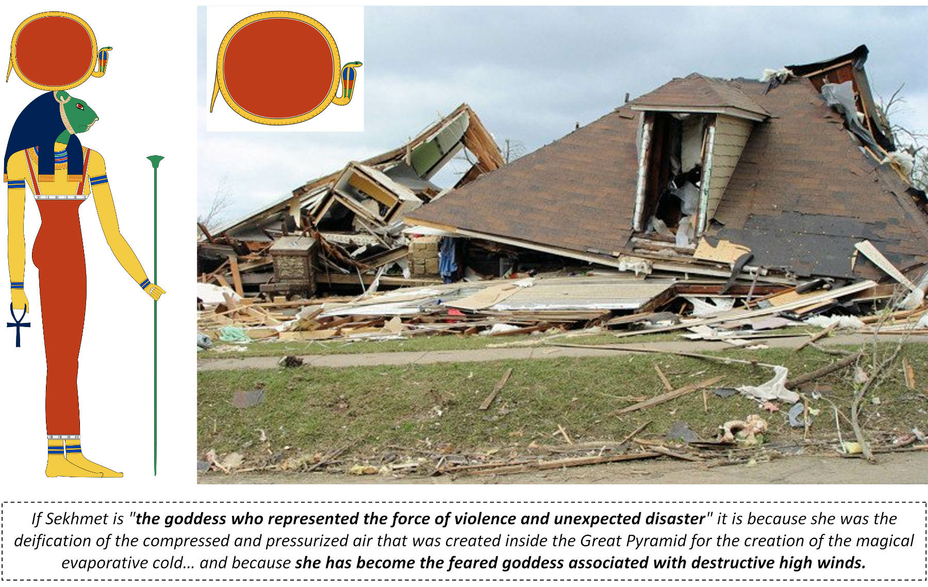
Collapsed home in Mena, Arkansas USA. Damages caused by a EF3 tornado on April 9, 2009 (3 fatalities and 30 injuries): https://commons.wikimedia.org/wiki/File:Mena_tornado_damage.jpg
27.24 The destructive Sekhmet high winds
I have to admit I am particularly happy to have understood Sekhmet, because where I'm living here in Brittany, high winds are a major problem; most of French people think the main inconvenience is the rain, but it is a misunderstanding of the region: wind is the problem; like it is at this very moment, with wind gusts at about 60 km/h.
But now, that I can call these wind gusts by their (ancient Egyptian) name, even if I'm not a religious person, I feel way better! Instead of being mad because of this (not so much) high winds, I'm just saying to myself: "Hello Sekhmet, how is it going? I hope you're not gonna stay too long, but until then, have a good day and please, don't get too much exited right!"
But we'll see how I will react when there is gonna be a 100 km/h Sekhmet in the next coming weeks… I even may become religious, and by myself a Sekhmet statue!
27.25 The seated and standing Sekhmet statues
A good metaphor we can use to represent Sekhmet, is the bicycle pump; because the first consequence of the fall of the impactor was the pressurization of the air imprisoned inside the central caisson, and the fact that this air would have been forced into the evaporative cooling passage.
It would have result in the creation of kind of a high wind inside the very structure of the Great Pyramid. This internal high wind was absolutely indispensable for the cooling process to occur because of the problem generated by the moist air of the previous cycle (most probably this air would have had a 100% humidity rate).
And I think that this internal high wind is explaining both the seated and standing statues of Sekhmet: the goddess has become associated with the high winds ancient Egyptians had to face in real life. The seated statues of Sekhmet would represent the calm, appeased and settling down winds, while the standing statues would represent the winds rising up and becoming dangerous and destructive.
We can imagine all kind of scenarios regarding the worship of the statues, but there is one thing that is puzzling, and it is about the fact that hundreds of them have been used, apparently in only two locations: the Mortuary Temple/Complex of Amenhotep III at Kom el Heittan and the Temple of Mut at Karnak.
"The origin of the Sekhmet statues was during the reign of Amenhotep III dynasty 18 (ca 1390-1352 BC). There have been more than six hundred statues that have been recovered from Egypt. Most of these Sekhmet statues were created under Amenhotep III. Sekhmet statues have been found at Amenhotep III Mortuary Temple/Complex at Kom el Heittan on the Theban West Bank and at the Temple of Mut at Karnak on the east bank of the Nile River at Thebes. Sekhmet statues can still be found and traced back to Amenhotep III. The Sekhmet statues are a part of his massive statuary program. Amenhotep III hoped that the Sekhmet statues would heal him from illness and bring him good fortune for the year. This is why there were so many Sekhmet statues being built and at such a fast pace. We can tell Amenhotep III favored the Sekhmet goddess since he used her statues so much for ritual practices. Many scholars believe that there were a total of 730 statues built which is two statues for everyday of the year." https://en.wikipedia.org/wiki/Sekhmet_statues
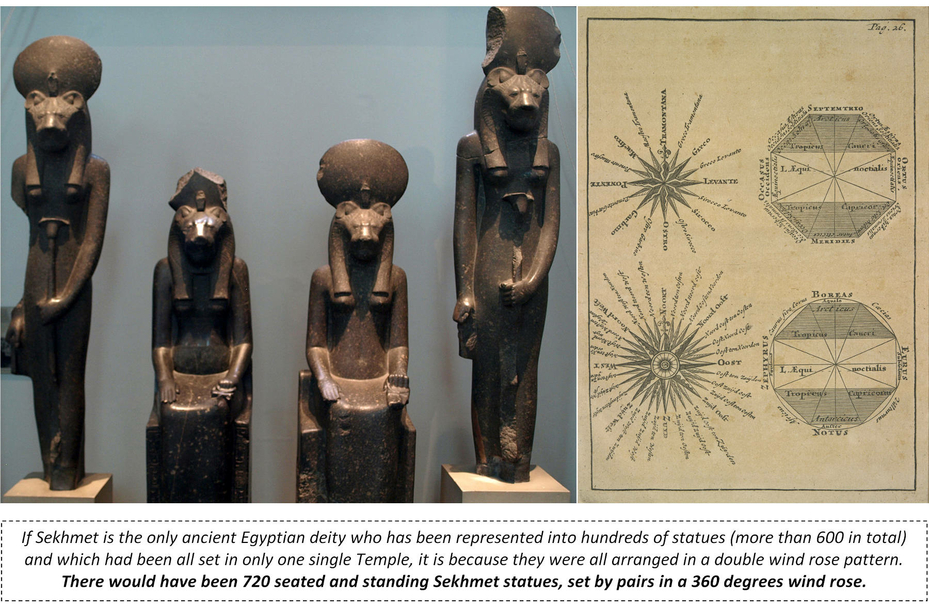
Four black granite statues of the goddess Sakhmet [=Sekhmet], all originally from Thebes, at the Temple of Mut. From the reign of Amenophis III, circa 1400 BCE: https://en.wikipedia.org/wiki/Sekhmet_statues#/media/File:FourStatuesOfGoddessSakhmet-FrontalView-BritishMuseum-August19-08.jpg
A medieval wind rose: https://en.wikipedia.org/wiki/Wind_rose
27.26 The Sekhmet statues were (most probably) arranged into a wind rose
It is said that scholars believe that 730 statues were built, because it represents twice the numbers of days in a year.
"Many scholars believe that there were a total of 730 statues built which is two statues for everyday of the year." https://en.wikipedia.org/wiki/Sekhmet_statues
I'm suggesting something else, because there is absolutely no reason what so ever that would explain why ancient Egyptians would have needed one statue of Sekhmet for every single day of the year, and they wouldn't have needed the same thing for every other deity.
Now that we know that Sekhmet is about the wind, there is something that is coming to mind right away: the wind rose, and its 360 degrees. Let's say that all, or most of the Sekhmet statues were dispatched into 2 locations, it would have needed 360 x 2 = 720 statues to reproduce the design of the wind rose.
The problem now would be to determine if the Sekhmet wind rose would have been created for worship or scientific purposes; and maybe probably for both reasons.
It would make more sense though, that the 720 Sekhmet statues would all be together at the same site, each seated statue paired with a standing statue.
Let's say that some wind would come from the north-east region, priests would come to the appropriate pair of Sekhmet statue and pray for the standing statue to get back to the seated statue, and let the wind calm down. Of course this is purely hypothetical.
27.27 The Sekhmet statues were (most probably) indeed all at the same place and arranged in some kind of "celestial" map
This idea that the Sekhmet statues were indeed all at the same place at the same time and arranged in a wind rose pattern, is reinforced by the following excerpt coming from the Metropolitan Museum:
"It was long thought that the king himself had erected statues in both places, but today many scholars believe that originally the statues all stood at the Kom el Heitan mortuary temple. There they formed part of Amenhotep’s massive statuary program. The Sakhmet statues have convincingly been shown to have constituted a "litany in stone" that appeased the goddess and invoked her not to use her negative powers, thereby delivering the king from illness and evil for a year. Based on our understanding of the litany, there may originally have been 730 statues, one seated and one standing for each day of the year. Moreover, it has been theorized they were arranged, along with other divine statues, across the giant courts at Kom el Heitan to form a vast celestial map that served as the king's eternal ritual calendar." ![]() https://www.metmuseum.org/art/collection/search/544484
https://www.metmuseum.org/art/collection/search/544484
You'll note that the MET is mentioning the term "celestial map", which would require like every other map, some kind of wind rose.
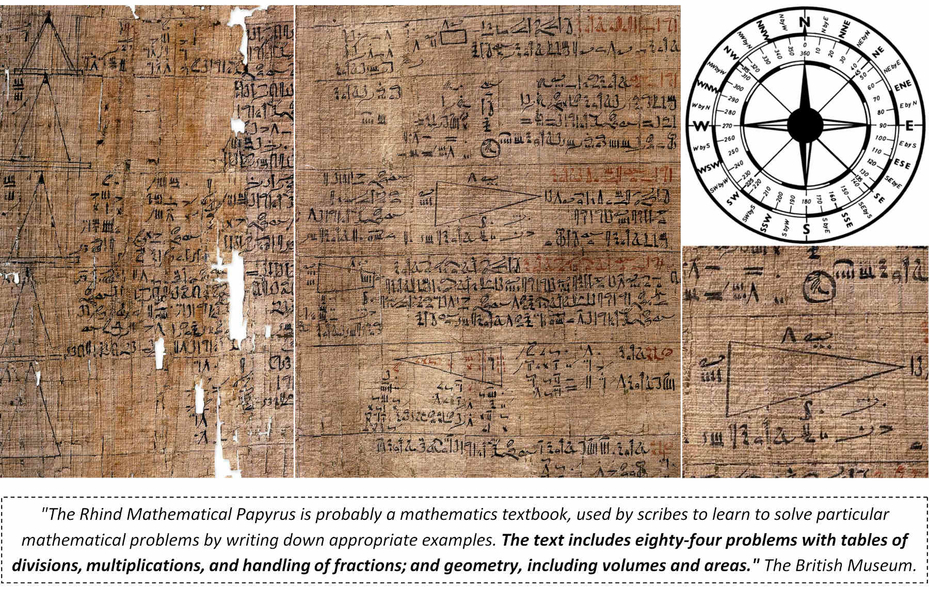
"The Rhind Mathematical Papyrus is probably a mathematics textbook, used by scribes to learn to solve particular mathematical problems by writing down appropriate examples. The text includes eighty-four problems with tables of divisions, multiplications, and handling of fractions; and geometry, including volumes and areas." Excerpt from The British Museum data sheet. The Rhind Mathematical Papyrus at the British Museum: https://www.britishmuseum.org/collection/object/Y_EA10057
Compass directions and bearings: https://scoutwiki.scouts.org.za/wiki/Compass#/media/File:Compass_directions_and_bearings.png
27.28 The ancient Egyptian mathematics and the wind rose
It looks like there is no final answer to the question about who came up with the idea of dividing a circle into 360 degrees, which a wind rose is all about: some people are praising the Mesopotamians, the Babylonians or the ancient Egyptians themselves.
" The Mesopotamians passed their base-60 numerical system to the ancient Egyptians, who used it to divide a circle into 360 degrees, Mary Blocksma writes in her book Reading the Numbers. The 360-degree circle worked out great: The Egyptians loved perfect triangles, and exactly six of them fit into a circle. Therefore, six triangular slices of 60 degrees each made for a sensible 360-degree dissection of a circle. The Egyptians, who invented the degree symbol, also came up with the first calendar based on a 360-day year, which is only off by 5.25 days. Since then, the 360-degree circle has more than stood the test of time, it has made its mark on time itself: When time was first recorded on the face of a circle, it was an easy leap to divide hours into 60 minutes and minutes into 60 seconds." https://www.popsci.com/scitech/article/2002-02/who-determined-circle-should-be-divided-360-degrees/
What is certain is that not only did the Egyptians invent the 24 hours in a day concept: https://www.scientificamerican.com/article/experts-time-division-days-hours-minutes/#:~:text=Hipparchus%2C%20whose%20work%20primarily%20took,varying%20hours%20for%20many%20centuries, but they also invented the 365 days calendar: "The ancient Egyptian calendar – a civil calendar – was a solar calendar with a 365-day year. The year consisted of three seasons of 120 days each, plus an intercalary month of five epagomenal days treated as outside of the year proper. Each season was divided into four months of 30 days." https://en.wikipedia.org/wiki/Egyptian_calendar
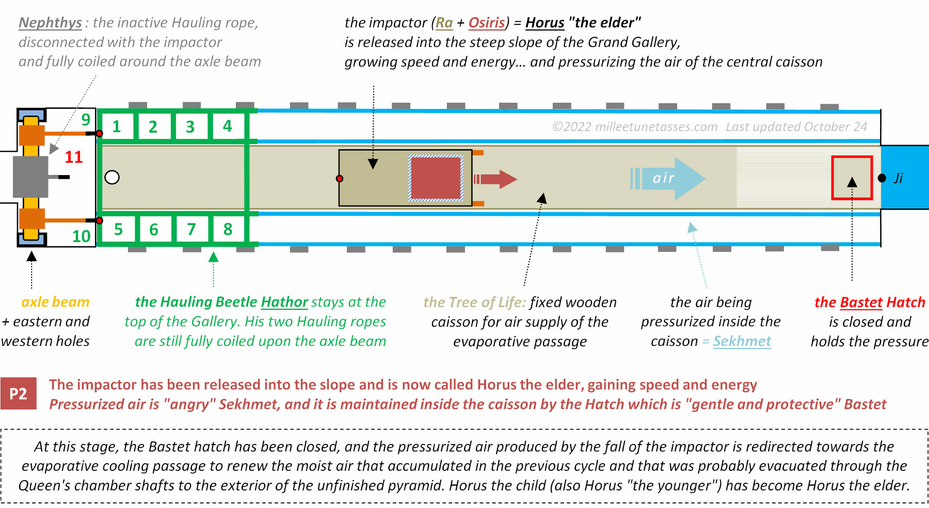
Of course, the impactor couldn't be seen inside the central wooden caisson; and the Hauling beetle is actually totally covering the caisson on both sides as well as on top: the central caisson also disappear completely underneath the Hauling beetle.
27.29 The operating cycle of the Grand Gallery • Position 2
• The impactor has been released into the slope and is now called Horus the elder, gaining speed and energy
Pressurized air is "angry" Sekhmet, and it is maintained inside the caisson by the Hatch which is "gentle and protective" Bastet.
27.30 The re-establishment of Maat by the union of Sekhmet (dry air of the caisson) and Ptah (water in the well)
Maat is one of the most beautiful metaphors of all, because she is the goddess of balance and harmony. It is a very cute story; but the real meaning of Maat is all about science: Maat is about the equilibrium which rules every basic scientific process, whether it is in physics or in chemistry.
My guess is that when Maat is used by ancient Egyptians, it is most of the time directly referring to the equilibrium of the evaporation process of water, when the liquid form (deified into god Geb) is transforming itself into the evaporated form (deified into the goddess Nut).
This is why "[The union of Sekhmet and Ptah] created Nefertum and so re-established Ma’at."
"In one version of the myth, Ptah is the first thing she sees upon awakening and she instantly falls in love with him. Their union (creation and destruction) created Nefertum (healing) and so re-established Ma’at." https://ancientegyptonline.co.uk/sekhmet/
The fact that Maat's emblem is the same feather as her brother's (Shu, the god of dry warm air), indicates that the equilibrium is all about the air. Maat is the glorification of the capacity of the air to charge itself with water: it is about dry air becoming moist air by accumulating humidity.
27.31 The question of knowing if the pressurized air really got inside the well
This question is fundamental, and I still can't answer it, even if in the following excerpt, it is said that "Ptah is the first thing she [Sekhmet] sees upon awakening and she instantly falls in love with him".
Because, Sekhmet is pressurized air and Ptah the inclined well, it clearly suggests that the air was indeed getting into the well. But I really have a problem with that, because the efficiency of the evaporative cooling process is entirely depending on the dryness of the air that is injected in the system: the dryer the air, the more water you can force into it and the colder it is gonna get.
I can't imagine that this same air would have first to get inside the water of the well, before passing through the fog nozzle, but maybe it wouldn't affect the air dryness that much, I don't know.
This is why I've implemented in previous draws, some hollowed out slots in the junction ramp. But then, it would mean that the space directly underneath the ramp would have been connected with the Grand Gallery by these slots… unless the impactor somehow covered these slots after the impact; but without a 3D model reconstruction of the area, it is very difficult to imagine a credible reconstitution at that point.
"In one version of the myth, Ptah is the first thing she sees upon awakening and she instantly falls in love with him. Their union (creation and destruction) created Nefertum (healing) and so re-established Ma’at." https://ancientegyptonline.co.uk/sekhmet/
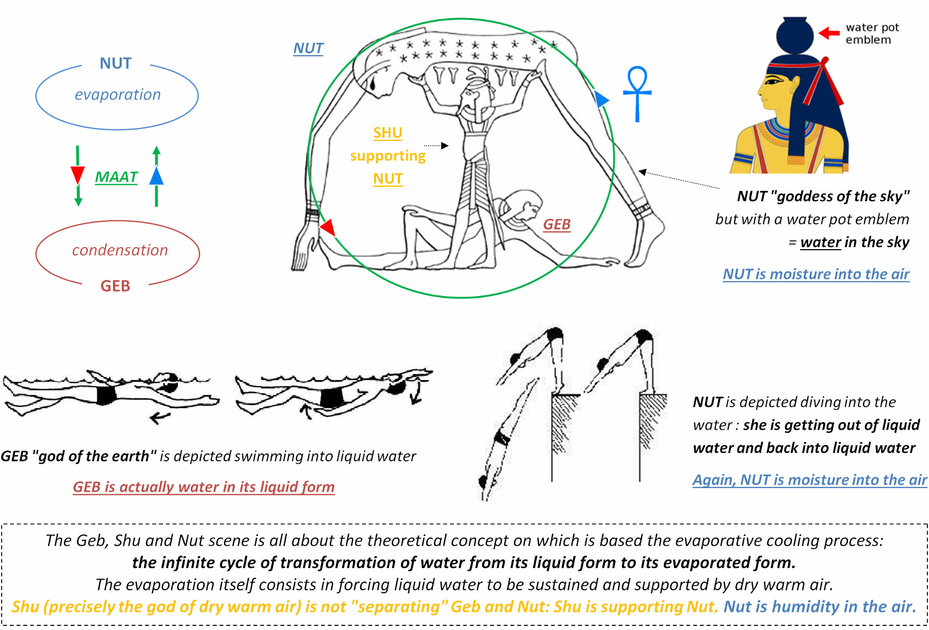
Diving drawing : https://www.mobilesport.ch/plongeon/plongeon-basics-chute/
Backstroke swimming technique : https://commons.wikimedia.org/wiki/File:Backstroke_(PSF).png
27.32 The ancient Egyptian glorification of the evaporation process of water...
The Geb, Shu and Nut scene is all about the theoretical concept on which is based the evaporative cooling process: the infinite cycle of transformation of water from its liquid form to its evaporated form. The evaporation itself consists in forcing liquid water to be sustained and supported by dry warm air. Shu (precisely the god of dry warm air) is not "separating" Geb and Nut: Shu is supporting Nut. Nut is humidity in the air. More on Geb, Shu and Nut in Section 3
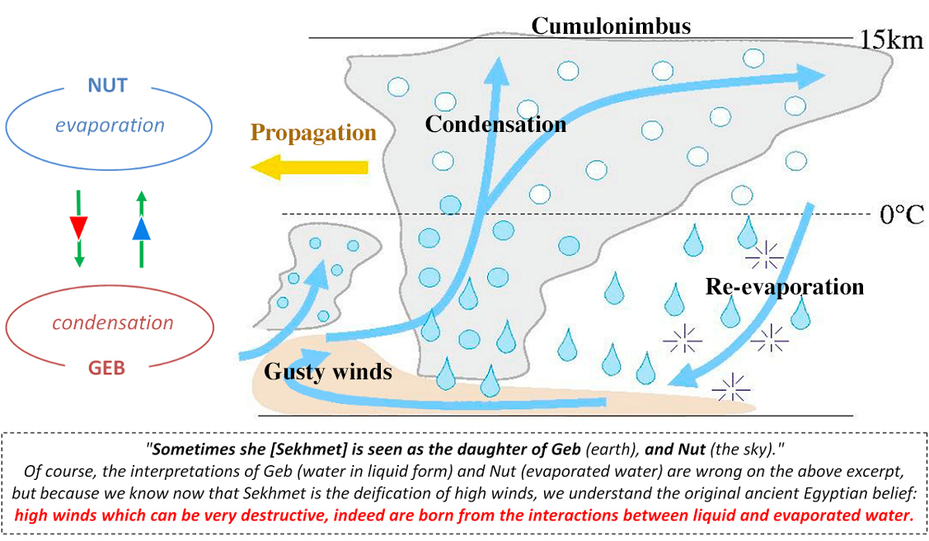
"Synthetic diagram of the functioning of a storm, with the representation of a gust capable of generating a new lift and propagating this storm to the left": https://www.encyclopedie-environnement.org/en/air-en/thunderstorms-electricity-in-the-air/
27.33 And its use in "gusty winds" Sekhmet seen as the "daughter of Geb, and Nut" searching for "blood"
Of course, the interpretations of Geb (water in liquid form) and Nut (evaporated water) are wrong on the above excerpt, but because we know now that Sekhmet is the deification of high winds, we understand the original ancient Egyptian belief: high winds which can be very destructive, indeed are born from the interactions between liquid and evaporated water.
"Sekhmet whose name means: “She who is powerful” or “the One who loves Ma’at” was […] created from the fire of the sun god Ra’s eye when he looked upon Earth. Ra created her as a weapon to destroy humans for their disobedience to him and for not living in accordance with the principles of Ma’at. Sometimes she is seen as the daughter of Geb (earth), and Nut (the sky)." https://egyptianmuseum.org/deities-sekhmet
"The myths go on to state that whenever she breathed out, fire came out. Her breath was like the hot winds that blew from the desert. […] In one incident, it was believed that Ra had gotten frustrated with mankind’s insolence and transgressions against the principles of Ma’at. The sun god unleashed Sekhmet (The Destroyer of Rebellion) upon the earth in order to teach humanity a painful lesson. The myth goes on to say that Sekhmet killed every one of Ra’s conspirators, leaving the land of Egypt in a pool of blood. Such was her unquenchable thirst for blood that Ra feared she would kill every living soul in Egypt." https://www.worldhistoryedu.com/sekhmet-myth-and-powers/
Of course, in the above excerpt, the "unquenchable thirst for blood" isn't at all really about blood: blood is another metaphor used to refer to water.
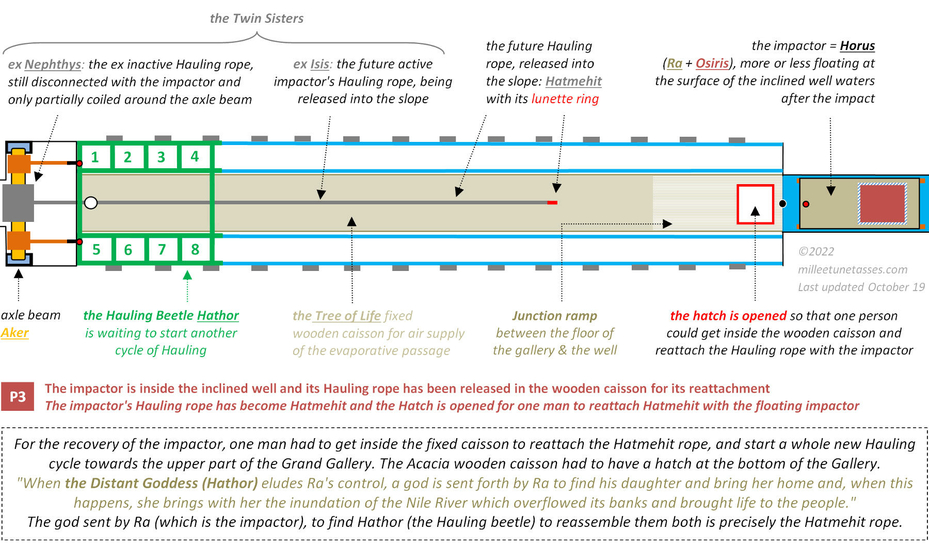
Of course, the impactor couldn't be seen inside the central wooden caisson; and the Hauling beetle is actually totally covering the caisson on both sides as well as on top: the central caisson also disappear completely underneath the Hauling beetle.
27.34 The operating cycle of the Grand Gallery • Position 3
• The impactor is inside the inclined well and its Hauling rope has been released in the wooden caisson for its reattachment. The Beetle has become Hathor: the Distant Goddess
The impactor's Hauling rope has become Hatmehit and the Hatch is opened for one man to reattach Hatmehit with the floating impactor.
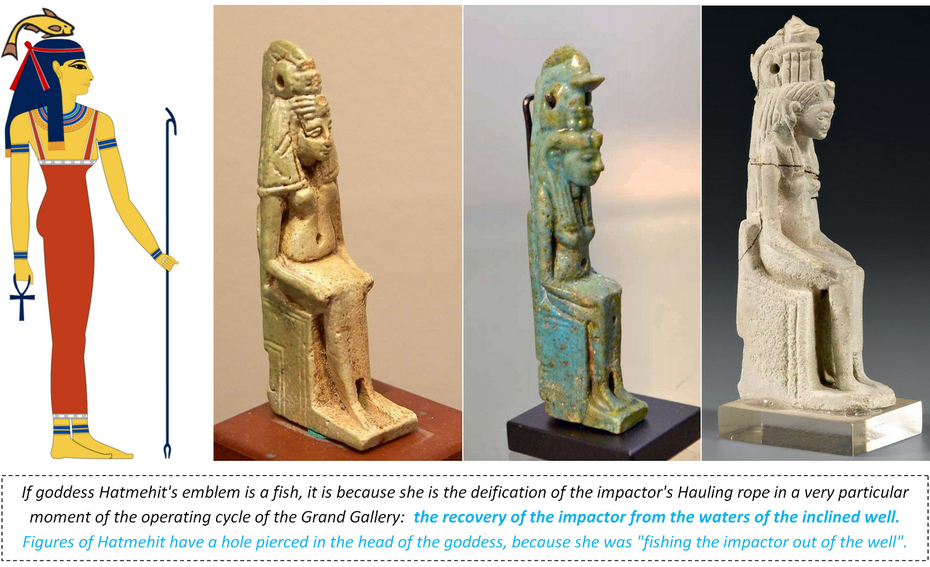
The idea that Hatmehit was the representation of a rope that was supposed to be reconnected with the impactor is probably the meaning of the hole that the figures of Hatmehit have directly in their heads: that hole was meant for the rope itself.
Draw of goddess Hatmehit by Jeff Dahl. Hatmehit figures: https://www.ecured.cu/Hatmehyt_(diosa_egipcia)#/media/File:Hatmehyt.jpg
https://www.trocadero.com/stores/explorer/items/1383416 and https://www.thierrydemaigret.com/lot/13797/2579392
27.35 Hatmehit is about the impactor's Hauling rope, just like Isis or Nephthys
Many references about Hatmehit are pointing to the same conclusion: Hatmehit is another name for the impactor's Hauling rope, the one which have been called Isis and Nephthys.
In particular, it is known that Isis, Nephthys and Hatmehit are all "searching for the body of Osiris", who is the impactor floating in the inclined well waters. It means that the three of them are all together about the same impactor's Hauling rope: "There is one note of a Nephthys-Hatmehit in a hieratic papyrus Book of Hours. Additionally, Herman de Meulenaere argues that due to Hatmehit's epithets describing her as one of the parties who search for the body of Osiris that pointed to a connection with Nephthys as well". https://en.wikipedia.org/wiki/Hatmehit
27.36 Hatmehit is the impactor's Hauling rope that was fishing the impactor out of the well
If goddess Hatmehit's emblem is a fish, it is because she is the deification of the impactor's Hauling rope in a very particular moment of the operating cycle of the Grand Gallery: the recovery of the impactor from the waters of the inclined well. Figures of Hatmehit also have a hole pierced in the head of the goddess, because she was "fishing the impactor out of the well".
"Hatmehyt was a fish-goddess worshipped in the Delta, particularly in the northeast at Mendes. The fish as a divinity is comparatively rare in the Egyptian pantheon, but Hatmehyt's name means "she who is in front of the fishes" […] At Mendes, in a district for which the ancient standard was the fish symbol indicating that Hatmehyt was the senior deity in terms of residence there, her cult becomes subordinated to that of the ram-god Banebdjedet - interpreted after his arrival as her consort." http://www.touregypt.net/godsofegypt/hatmehyt.htm
27.37 When the Hatmehit rope is becoming the Isis impactor's Hauling rope
We've seen that Isis is the rope actually involved in the act of towing the impactor (the active rope), when Nephthys is the same rope, but inactive, completely coiled upon the axle beam and disconnected with the impactor.
This part is crucial, because it is unimaginable that the impactor would be released into the slope of the Gallery, if it was still connected with the towing rope: the central rope absolutely had to be disconnected before the release of the impactor; hence the necessity to have the Bastet Hatch at the bottom of the central caisson, to reconnect the rope with the impactor.
It means that there is here another part of the operating cycle of the rope: the rope that is descending inside the central wooden caisson after the impactor had rammed into the waters of the well.
Hatmehit is about this part of the operating cycle; it is about the reattachment of the towing rope with the impactor. In other words, Hatmehit is about the birth (so to speak) of Isis.
When it is known that "Isis would begin to take the role of Hatmehit", it is actually all about the opposite: it is Hatmehit who is supposed to become Isis: "In earlier periods, Hatmehit was considered her own goddess. However from the Third Intermediate Period onwards, Isis would begin to take the role of Hatmehit in the local cult, with Hatmehit being considered a form of Isis particular to Mendes." https://en.wikipedia.org/wiki/Hatmehit
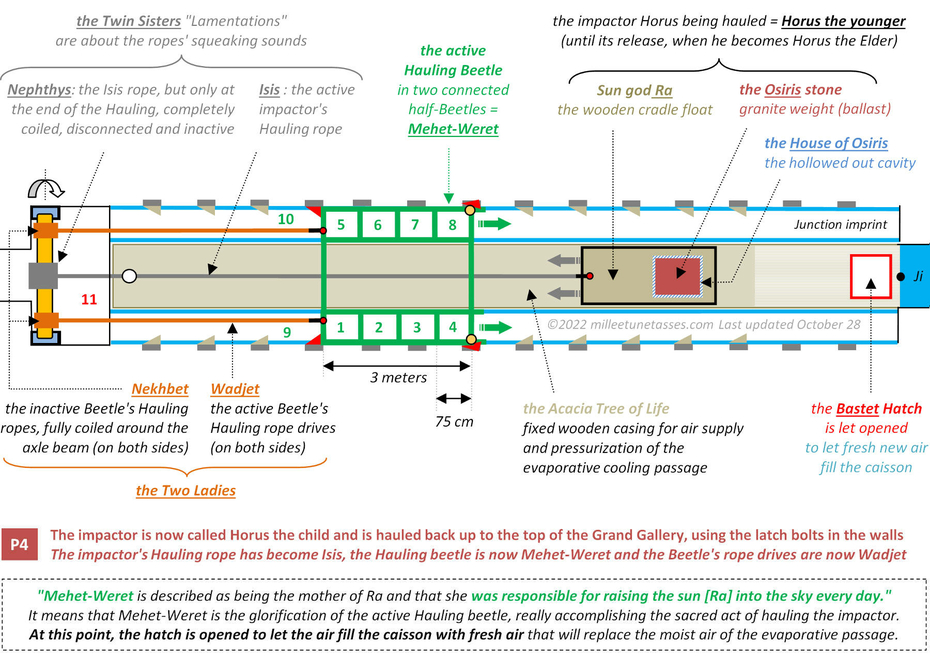
"Mehet-Weret is described as being the mother of Ra and that she was responsible for raising the sun [Ra] into the sky every day." It means that Mehet-Weret is the glorification of the active Hauling beetle, really accomplishing the sacred act of hauling the impactor.
At this point, the hatch is opened to let the air fill the caisson with fresh air that will replace the moist air of the evaporative passage.
27.38 The operating cycle of the Grand Gallery • Position 4
• The impactor is now called Horus the child and is hauled back up to the top of the Grand Gallery, using the latch bolts in the walls
The impactor's Hauling rope has become Isis, the Hauling beetle is now Mehet-Weret and the Beetle's rope drives are now Wadjet.
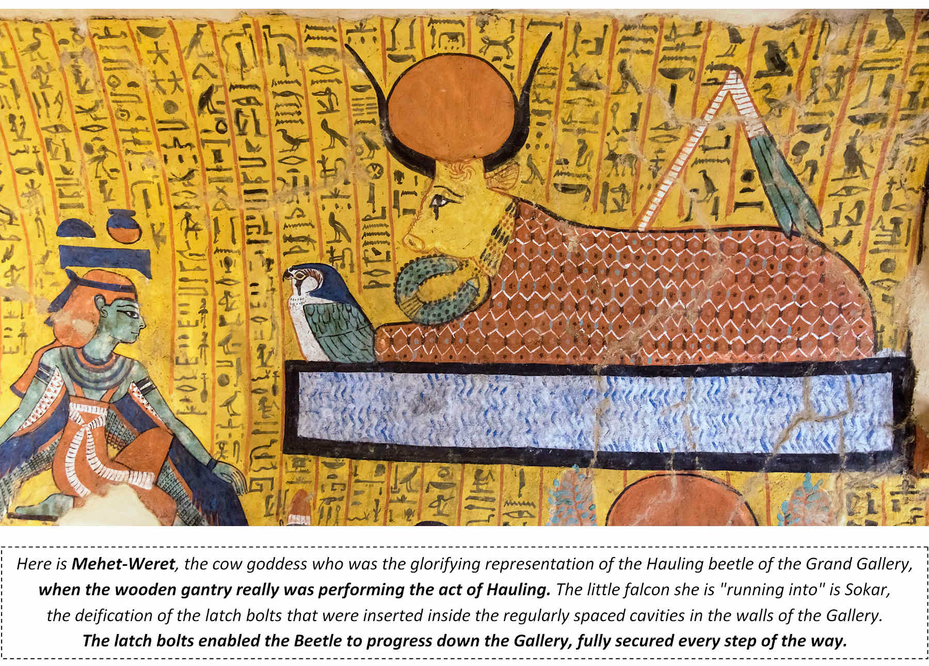
Mehet-Weret in the tomb of Irynefer at Deir el-Medina (TT290), in front of goddess Nut. Photograph thanks to kairoinfo4u: https://www.flickr.com/photos/manna4u/11433106165/in/photostream/
27.39 Hathor isn't the Hauling beetle actually performing the act of towing: it was Mehet-Weret
I've already mentioned in previous Sections, the fact that Hathor was a representation of the Hauling beetle, but I was wrong in the way I've presented it, saying that the Beetle was Hathor and that both of them were the deification of the Beetle really towing the impactor.
The cow goddess Hathor is actually just one out of many representations of the Beetle: Egyptians did the same thing with the Beetle that what we've already seen with the ropes. It didn't matter if there was only one hauling rope for the impactor, this rope had been deified at least three times in Isis, Nephthys and Hatmehit (and maybe there is or there are other representation(s) of this rope that I still didn't get).
Until today, I thought Hathor was the "active" Hauling beetle, really accomplishing the act of towing; and that was a mistake: Mehet-Weret is the deification of the active Beetle.
27.40 Mehet-Weret is the active Beetle performing the act of towing the impactor
When it is said that Mehet-Weret was responsible for "raising Sun god Ra into the sky every day", we simply have the answer to who was the deification of the active towing Hauling beetle; and it was her Mehet-Weret, because Ra is the impactor.
"Mehet-Weret was responsible for raising the sun into the sky every day." […] "Mehet-Weret is described as being the mother of Ra, the ancient Egyptian solar deity. As the Goddess of Creation, she gives birth to the sun every day and is the reason the world isn't in the dark. In her physical description, she is described as having a sun disk between her horns; in typical motherly fashion, she protects her son Ra and keeps him close to her." https://en.wikipedia.org/wiki/Mehet-Weret
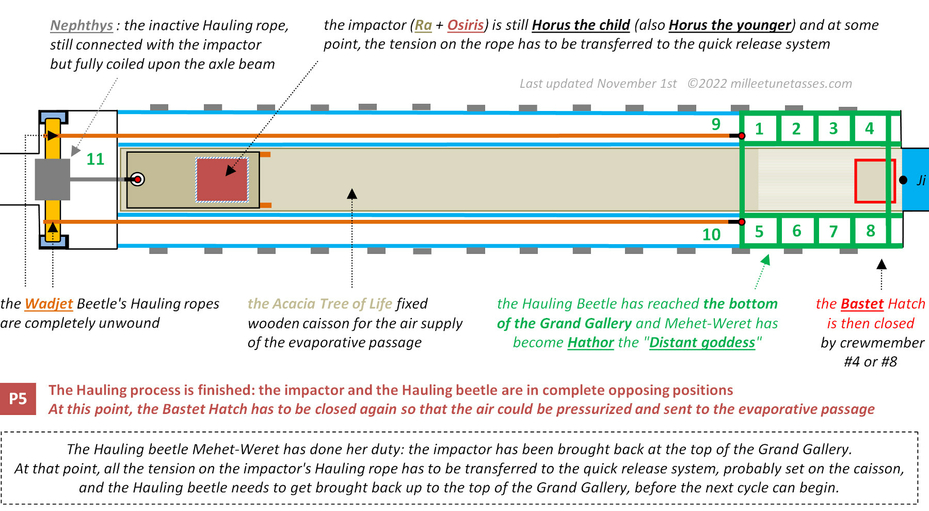
The Hauling beetle Mehet-Weret has done her duty: the impactor has been brought back at the top of the Grand Gallery.
27.41 The operating cycle of the Grand Gallery • Position 5
• The Hauling process is finished: the impactor and the Hauling beetle are in complete opposing positions
At this point, the Bastet Hatch has to be closed again so that the air could be pressurized and sent to the evaporative passage.
All the tension on the impactor's Hauling rope has to be transferred to the quick release system, probably set on the caisson, and the Hauling beetle needs to get brought back up to the top of the Grand Gallery, before the next cycle can begin.
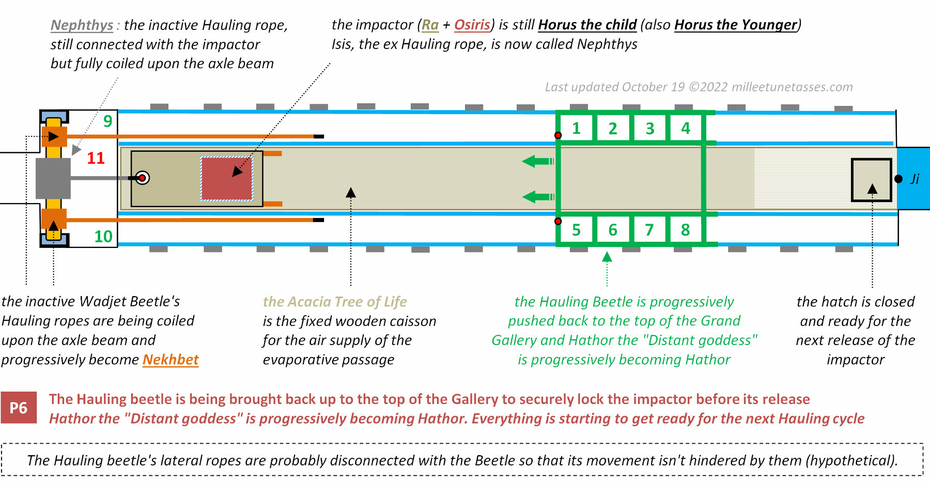
The Hauling beetle's lateral ropes are probably disconnected with the Beetle so that its movement isn't hindered by them (hypothetical).
27.42 The operating cycle of the Grand Gallery • Position 6
• The Hauling beetle is being brought back up to the top of the Gallery to securely lock the impactor before its release
Hathor the "Distant goddess" is progressively becoming Hathor. Everything is starting to get ready for the next Hauling cycle.
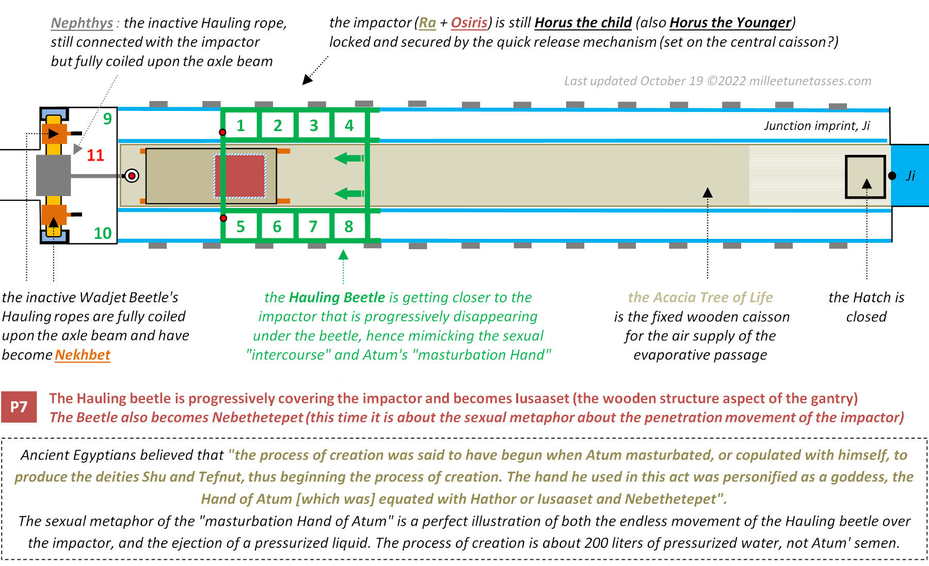
Ancient Egyptians believed that "the process of creation was said to have begun when Atum masturbated, or copulated with himself, to produce the deities Shu and Tefnut, thus beginning the process of creation. The hand he used in this act was personified as a goddess, the Hand of Atum [which was] equated with Hathor or Iusaaset and Nebethetepet".
This sexual metaphor of "the Hand of Atum" is perfectly depicting the continuous and simultaneous relative movement of the impactor inside the Hauling beetle, that was endlessly "passing through" or "penetrating" the Beetle… and resulting in the ejection of pressurized liquid: the about 200 liters of pressurized water that endlessly, all day long, were creating the evaporative cold in the horizontal passage.
27.43 The operating cycle of the Grand Gallery • Position 7
• The Beetle is progressively covering the impactor and becomes Iusaaset (the wooden structure aspect of the gantry)
The Beetle also becomes Nebethetepet (this time it is about the sexual metaphor about the penetration movement of the impactor).
27.44 Nebethetepet is about the penetrating movement of the impactor "inside" the wooden structure Iusaaset
What seems to be the most significant aspect of Nebethetepet, the "Satisfied Lady" is her "sexual" side, as in her epithet of "Mistress" that is used in Mistress of Offerings, Mistress of Hetepet and Mistress of the uterus and Mistress of the Vulva.
It could indicate that Nebethetepet was the vision of the Hauling beetle in movement towards the impactor, and that the metaphor used in her case is about the sexual intercourse, when the impactor was cycle after cycle endlessly "penetrating" inside the wooden structure that would have appear like two opened legs over the impactor.
It would mean that the Hauling beetle could have been called Nebethetepet only when the gantry was slowly closing to the impactor Horus the child, who was "waiting" for the Beetle at the top of the Gallery, at the very end of every cycle.
"Nebet-hetepet (nb.t-ḥtp.t) is an ancient Egyptian goddess. Her name means "Lady of the Offerings" or "Satisfied Lady". She was worshipped in Heliopolis as a female counterpart of Atum. She personified Atum's hand, the female principle of creation, and could also be a title for Hathor, but aside from that had little significance." https://en.wikipedia.org/wiki/Nebethetepet
"Iusâas is also known as Nebet-Hetepet, ‘Mistress of Hetepet’, a cult site in the vicinity of Heliopolis. This epithet also, however, has the meaning of ‘Mistress of the Vulva’ as well as ‘Mistress of Offerings’, thereby expressing a conception of divine offerings as that which brings forth the latent potency of the Gods into generative expression. The epithet Nebet-Hetepet is frequently borne by Hathor as well, who is the Goddess of sexual satisfaction in a broader sense. Iusâas and Nebet-Hetepet sometimes appear to be distinct Goddesses; closer investigation, however, tends to reveal that when the distinction between Iusâas and Nebet-Hetepet is genuine, it is because it is Hathor to whom the epithet ‘Nebet-Hetepet’ is being ascribed (Vandier 1964-66)." https://henadology.wordpress.com/theology/netjeru/iusaas/
"The cult of Iusaas was associated with that of another heliopolitan goddess: Nebet-Hetepet. There are also several suggestions regarding her name: Lady of contentment; Mistress of Offering; or simply "Misteress of Hetepet". Troy explains that Htpt is generally determined by the water-filled well which is found in Hmt, woman and wife. Accordingly, it is related to the female reproductive organs. It also might betranslated as "uterus", which is considered a place of rest, Htp. Hence, Nebet-Hetepet could mean Mistress of the uterus." Goddess Iusaas (A study about her iconography and her religious role in Ancient Egypt), by Dina Ezz El-Din: https://www.academia.edu/43571020/Goddess_Iusaas_A_study_about_her_iconography_and_her_religious_role_in_Ancient_Egypt
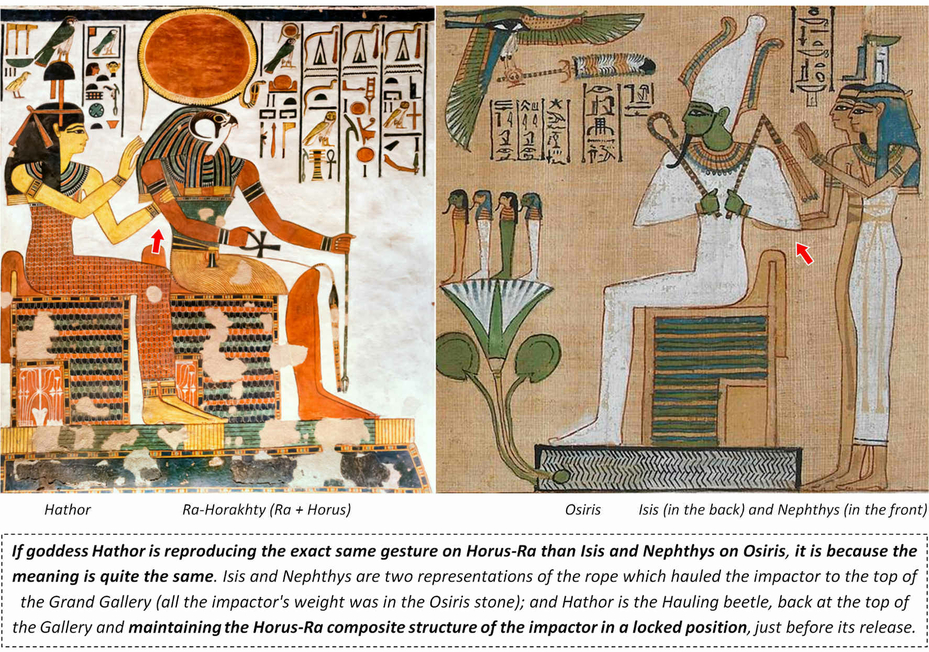
Ra-Horakhty and Hathor in the tomb of Nefertari, QV66, in the Valley of the Queens. Photograph by kairoinfo4u: https://www.flickr.com/photos/manna4u/33976926276/in/photostream/
Book of the Dead of Hunefer (Hw-nfr) frame 3, at the British Museum: https://www.britishmuseum.org/collection/object/Y_EA9901-3
27.45 The Hauling gestures performed by Hathor, Isis and Nephthys
If goddess Hathor is reproducing the exact same gesture on Horus-Ra than Isis and Nephthys on Osiris, it is because the meaning is the same. Isis and Nephthys are representations of the rope which hauled the impactor to the top of the Grand Gallery (all the impactor's weight was in the Osiris stone); and Hathor is the wooden gantry structure, the Hauling beetle which hauled the Horus composite structure of the impactor, including the wooden cradle float: Ra.
27.46 When falcon headed Ra-Horakhty as the deification of the impactor is represented creating the pressurized air inflated snake of Sekhmet, right over his head
An interesting point to note on the Ra-Horakhty deity, who is representing the impactor in its "visible" nature (Ra is the wooden part of the impactor and Horus the entire composite structure), is that:
• he is not wrapped in bandages like Osiris is (Osiris was actually really wrapped in linen or tissue inside his hollowed out cavity "House of Osiris"), on the contrary he is depicted with a falcon's head referring to the speed and energy of the impactor
• he has above the head the same inflated snake that Sekhmet has, and that is to show that during his dive/fall into the slope of the Gallery, the impactor was the one which created the pressurized air
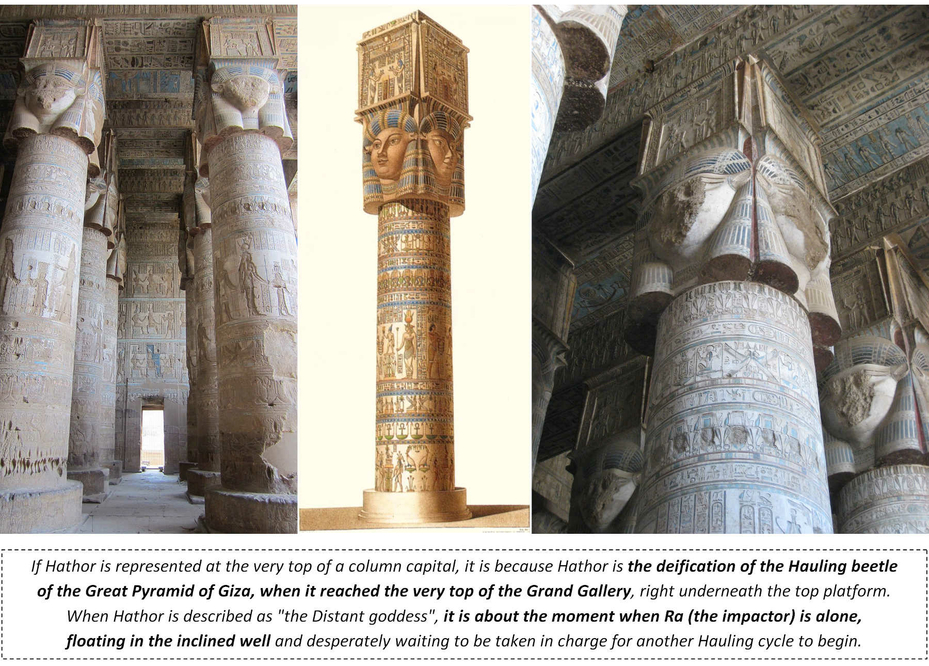
Hypostyle hall of the Temple of Hathor at Dendera, photographed by A. Parrot: https://en.wikipedia.org/wiki/Hathor#/media/File:Dendera_hypostyle_hall_crosswise.jpg
Hathor column at Dendera: https://upload.wikimedia.org/wikipedia/commons/7/75/Hathor_column_dendera.png
Hathor columns and breathtaking ceiling at Dendera, by Karen Green: https://www.flickr.com/photos/19479358@N00/4416542140
27.47 The Distant goddess Hathor
If Hathor is represented at the very top of a column capital, it is because Hathor is the deification of the Hauling beetle of the Great Pyramid of Giza, when it is back to the very top of the Grand Gallery, right underneath the top platform after having done its hauling job.
When Hathor is described as "the Distant goddess", it is about the moment when Ra (the impactor) is alone and floating in the inclined well, desperately waiting to be taken in charge for another Hauling cycle to begin.
27.48 When the impactor Ra is sending the Hatmehit rope to reconnect with the Distant Goddess Hathor Hauling beetle
For the recovery of the impactor, one man had to get inside the fixed caisson to reattach the Hatmehit rope, and start a whole new Hauling cycle towards the upper part of the Grand Gallery. The Acacia wooden caisson had to have a hatch at the bottom of the Gallery.
"When the Distant Goddess (Hathor) eludes Ra's control, a god is sent forth by Ra to find his daughter and bring her home and, when this happens, she brings with her the inundation of the Nile River which overflowed its banks and brought life to the people."
The god sent by Ra (who is the impactor), to find Hathor (the Hauling beetle) to reassemble them both is precisely the Hatmehit rope.
In the following excerpts, many parts are gonna ring a bell if you've already worked your way through all the Pyramids of the Cold Sections 23 and the more recent ones, which are little by little deciphering the metaphoric representations of the ropes of the Grand Gallery.
All excerpts are from https://en.wikipedia.org/wiki/Hatmehit
• Isis, Nephthys and Hatmehit are all "searching for the body of Osiris" (they are all together about the impactor's Hauling rope): "There is one note of a Nephthys-Hatmehit in a hieratic papyrus Book of Hours. Additionally, Herman de Meulenaere argues that due to Hatmehit's epithets describing her as one of the parties who search for the body of Osiris that pointed to a connection with Nephthys as well".
• "Hatmehit being considered a form of Isis": "In earlier periods, Hatmehit was considered her own goddess. However from the Third Intermediate Period onwards, Isis would begin to take the role of Hatmehit in the local cult, with Hatmehit being considered a form of Isis particular to Mendes. This was prompted by the growing association between Banebdjedet and Osiris, with Banebdjedet being considered the ba of Osiris. This is also evidenced by her epithets "She who looks for (the members of) her brother on the flow" and "The excellent Sister of He who wakes healthy (=Osiris)".
and: "The Dendera temple complex contains the most evidence of the connection between Isis and Hatmehit, where Isis is referred to explicitly as Hatmehit on two occasions. The first is on the wall of the mysterious hall in a series of inscriptions about Isis visiting the various nomes. When they get to Nome 16 of Lower Egypt it states: "The king of Upper and Lower Egypt, the son of Ra comes to you, Isis the great, the mother of the god, mistress of Iatdi. He brings you to the capital of the Mendesian nome carrying his possessions, it garnishes your chapel, you are Hatmehit, sovereign in Mendes, who seeks (the members of) her brother on the flow."
• Hatmehit's connection with Banebdjedet: "As the connection between Isis and Hatmehit became stronger, eventually Isis was shown as part of the Mendesian triad without necessarily being explicitly identified as Hatmehit. For example, a stela from Mendes from the reign of Iuput II depicts an offering being given to a triad of Banebdjedet, Isis the Great, and Harpocrates. Another stela depicts Ptolemy II Philadelphus making an offering to the deified Arsinoe II, the ram of Mendes, Banebdjedet the ba of Osiris, and a figure with the inscription "Isis the Great Hatmehit".
• Hatmehit's connection with Hathor and Mehet-Weret: "Hatmehit is considered by some Egyptologists to be connected with Hathor. Hathor is one of the oldest deities of Egypt who also went by the name Mehet-Weret, meaning "great flood". This may possibly be due to being seen as a remnant of the primal waters of creation from which all things arose. Other goddesses associated with the primal waters of creation are Mut and Naunet."
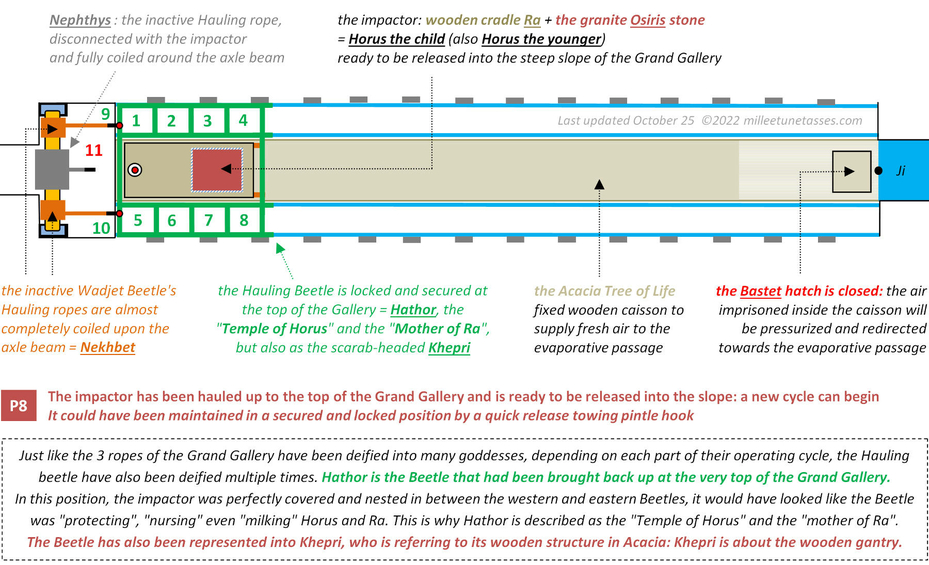
27.49 The operating cycle of the Grand Gallery • Position 8
• The impactor has been hauled up to the top of the Grand Gallery and is ready to be released into the slope
A new cycle can begin; back to Position 1.
27.50 Iusaaset: the wooden Acacia Structure of the Hauling beetle that looked like a scarab
If many aspects of Nebethetepet are about the movement of the Hauling beetle, Iusaaset is on the contrary all about its structure that resembled to a scarab beetle: not only Iusaaset is described with a scarab beetle on her head, but she is also directly associated with the Acacia tree.
But because Iusaaset is also about the movement of the impactor inside the structure, it means that Iusaaset is the Hauling beetle approaching the top of the Grand Gallery and the impactor itself: the more the structure is approaching the impactor and the top platform, the bigger it looks from the platform.
"The process of creation was said to have begun when Atum masturbated, or copulated with himself, to produce the deities Shu and Tefnut, thus beginning the process of creation. The hand he used in this act was personified as a goddess, the Hand of Atum. She was equated with Hathor or Iusaaset and Nebethetepet, two other, more minor goddesses.[4] The earliest texts to mention them seem to treat Iusaaset and Nebethetepet as two names for a single goddess, but after the time of the Middle Kingdom (c. 2000–1700 BC) they were treated as separate, although similar, deities. The name "Iusaaset" means something resembling "She who grows as she comes" and "Nebethetepet" means "Lady of the Field of Offerings" https://en.wikipedia.org/wiki/Iusaaset
"Iusaaset is a primordial goddess in Ancient Egyptian religion, a feminine counterpart to the male creator deity Atum. Iusaaset was depicted as a woman with a scarab beetle on her head."
"Iusaaset was associated with the acacia tree and acacias stood at the sanctuary dedicated to Iusaaset at Heliopolis."
"In very ancient times she was seen as “the great one who comes forth” https://iseumsanctuary.com/2022/02/14/goddess-of-the-tree-of-life/
"In Ancient Egyptian art, Iusaaset appears as a woman wearing the horned vulture crown with the uraeus and the solar disk in it, and she carries an ankh in one hand and a scepter in the other. The Egyptian vulture, most sacred to the ancient Egyptians and symbolizing Nekhbet, one of the Two Ladies protecting Egypt, was thought to reproduce though parthenogenesis also. This association might be the basis for the similar view about the motherhood of Iusaaset. The vultures also were considered extremely good mothers. The horns, the uraeus, and the solar disk make a religious connection to Bat and Hathor."
https://religion.fandom.com/wiki/Iusaaset
27.51 The shift change chaos because of Hathor and the 8 "dead" crewmembers
The P8 position in the operating cycle of the Grand Gallery was certainly the moment when a shift change could have been proceeded. And that could be the origin of the "troublesome" side of Hathor: it is only when the Hauling beetle was at the very top of the Grand Gallery, locked and secured, that any shift change could have occurred.
It means that the entire team of the 8 crewmembers would have to get out of the gantry, to be replaced by a brand new team; and I can only imagine the chaos it would cause. The "chaos in the human world", created by Hathor is probably all about this shift change.
From a certain point of view, the 8 crewmembers leaving their posts, could also have been seen as "dead", just like we all are after a very intense physical activity. The 8 leaving crewmembers certainly didn't say "oh, kill me now", but they were probably quite dead anyway!
"Myth of the Heavenly Cow" by Nadine Guilhou tells the story of a separate goddess that is related to Mehet-Weret who is named Hathor. Hathor is seen as more troublesome than Mehet-Weret, because she creates chaos in the human world. The title of the story of the “Myth of the Heavenly Cow” is also known as “The Destruction of Mankind” because Hathor was sent to kill the rebels who acted against the sun god Ra and his plans to rearrange the cosmos. While Hathor is the bloodthirsty warrior cow, focused on the destruction of humankind, Mehet-Weret is responsible for creating some of the most basic needs for humankind: sun and water." https://en.wikipedia.org/wiki/Mehet-Weret
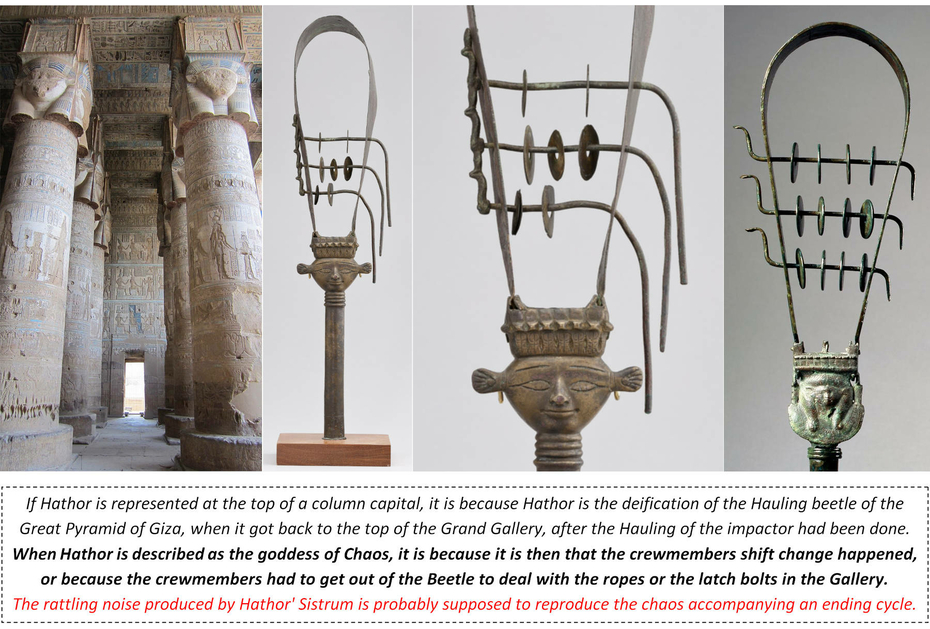
Hypostyle hall of the Temple of Hathor at Dendera, by A. Parrot: https://en.wikipedia.org/wiki/Hathor#/media/File:Dendera_hypostyle_hall_crosswise.jpg
Sistrum with Image of Hathor on Handle at the Michael C. Carlos Museum, Emory’s Atlanta campus: https://collections.carlos.emory.edu/objects/13693/sistrum-with-image-of-hathor-on-handle
Sistrum of the Chantress Tapenu at the Metropolitan Museum of Art, New-York: https://www.metmuseum.org/art/collection/search/553814
27.52 The sistrum also stands for the agitation and noises caused by the Hauling beetle shift change
If Hathor is represented at the very top of a column capital, it is because she is the deification of the Hauling beetle of the Great Pyramid when it reached the top of the Grand Gallery, underneath the top platform and ready for a shift change.
Hathor is the goddess of Chaos, precisely because of this shift change that would made a lot of agitation and noises.
The sistrums with Hathor's head on them are simply recreating, or recalling these noises caused by the shift changes.
It is also very interesting to note that about 90% of sistrum have three horizontal wires, sometimes taking the aspect of snakes. We've seen that snakes, not only were representations of water but also stood for ropes.
It would make the sistrum a complete reproduction of the Hauling beetle, with the three ropes of the Gallery and Hathor as the Beetle itself.
When there is a fourth horizontal wire, it is sometimes clearly set separately from the three other ones, which are arranged in some kind of a cluster, and it should represent the axle beam, maybe.
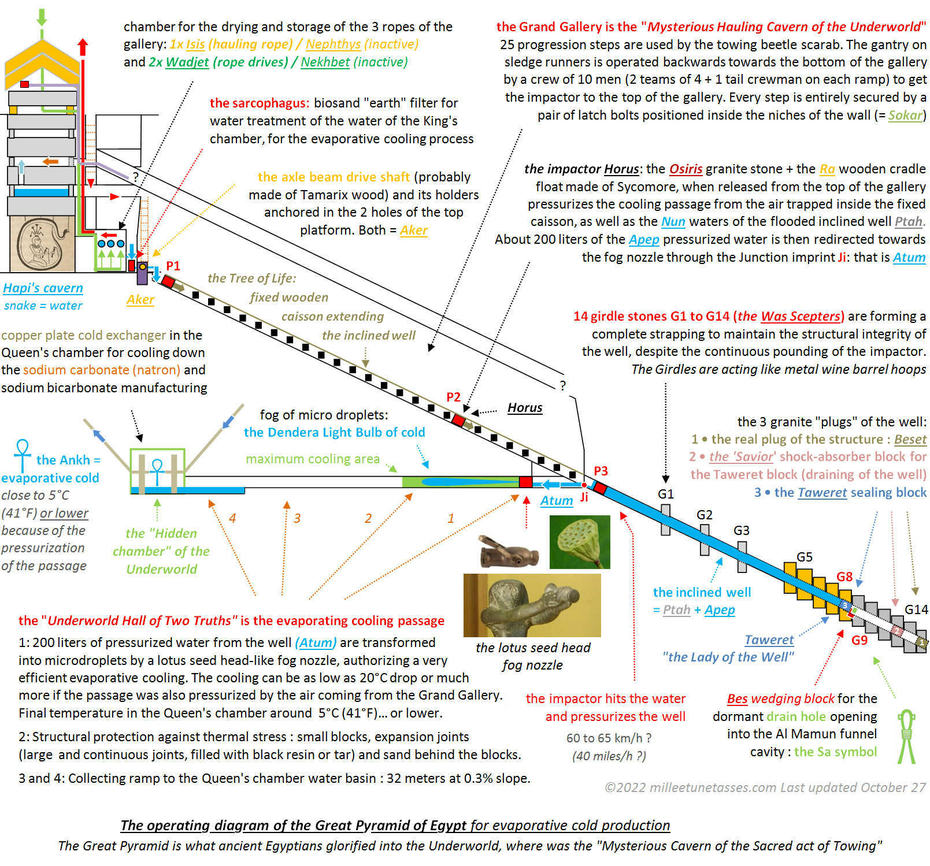
27.53 The operating diagram of the Great Pyramid of Egypt for evaporative cold production
The Great Pyramid is what ancient Egyptians glorified into the Underworld, where was the "Mysterious Cavern of the Sacred act of Towing".
27.54 Summary of the study: hidden behind the academic vision of the ancient Egyptian religion, a vast number of metaphors are describing some of the most advanced science and technological knowledge of that time : ancient Egyptian gods were nothing else than pharaohs' metaphoric self-glorifications of their theoretical and experimental scientific accomplishments in physics and chemistry.
Pharaohs used the power of Science to legitimate themselves as kings of Egypt : they forged an entire religion, based on science to rule their kingdom, and they presented that science as Magic.
The end game of this technological program that probably started on the very first Dynasty, was the Great Pyramid of Giza where evaporative cooling was engineered in the known part of the pyramid from the pressurized water produced in the inclined well, known today as the ascending passage.
The evaporative cold simply took advantage of the power of water, and was most probably necessary to cool down chemical manufacturing of sodium carbonate and sodium bicarbonate produced by an ammonia-soda Solvay process, as suggested by the very strong ammonia smell and the limestone kiln in the so-called burial chamber of the Red Pyramid. At that time, sodium carbonate was called natron, and it was the salt used for the mummification of the pharaohs (Sections 14, 15 and 16).
The cooling seems to have represented the most difficult part of the process, as suggested by the Step Pyramid's official name : according to scholars, the very first pyramid complex, the Step Pyramid of Djoser, was called "the refreshment of the Gods". No doubt that a more accurate translation would certainly be "the cooling of the Gods".
It means that ancient Egyptians were the first civilization to master a Solvay-like process for sodium carbonate manufacturing, long before it got reinvented in the 1800's in Europe. The key elements of that process is the temperature control of the chemical reactions (the cooling), and the dome shaped plate necessary for the counterflow chemical reactions to occur in an efficient way. That counterflow reaction plate is what really is the disc of Sabu.
As shown with Akhenaten and Nefertiti, the creation of the evaporative cold was the most sacred accomplishment of all (Section 17), and this is exactly what the Dendera Light is all about : the Dendera Light is the fog of microdroplets of liquid water that evaporates and creates the cold. Talking about the snake inside the Dendera Light Bulb : "The field surrounding Ra’s snake form is referred to in ancient Egyptian literature as protective magical energy in liquid form that all gods and pharaohs possess" (Faulkner, Section 2).
Everything that had been done in the Great Pyramid of Giza inspired most of the ancient Egyptian religion, and it had been glorified into what we know today as the Underworld.
The Underworld is referring to the chambers and passages of the Great Pyramid of Khufu, and in particular to the Grand Gallery where a hauling gantry beetle operated a wooden coffin shaped impactor that had a small nested granite block inside it. The impactor generated endlessly, over and over, maybe every 15 minutes the pressurized water that was then transformed into a fog of microdroplets inside the horizontal cooling passage.
The Grand Gallery of the Great Pyramid where the act of hauling was done, is the "Secret Hauling Cavern of the Underworld" described in the Amduat "Book of the Hidden Chamber".
The most important chamber of the Great Pyramid wasn't the King's chamber that only was the main water tank of the pyramid, but the Queen's chamber, the only one on the central axis of the pyramid. Because the Queen's chamber was inaccessible from the rest of the pyramid, it was glorified into the "Hidden Chamber of the Underworld" (Section 11), and because the Queen's chamber was the coolest place in the pyramid (about 5°C / 41°F), and with a constant 100% Humidity rate, this chamber was the one where the biggest amount of very hard salt encrustation had been documented by the first explorers of the pyramid in the 1800's and before it had been removed in 1998 by Zahi Hawass (Section 1). Very hard salt encrustation is the signature of the evaporative cooling process, even nowadays.
The most incredible thing is that pretty much everything I've just said, actually appears in many myths, and they don't even originate from ancient Egypt : the "Churning of the Ocean" Hindu myth that produces the immortal nectar Amrita, the Tibetan Prayer Wheels operated to give small amounts of 'merit' to too lazy Naga snakes, and the entire Norse mythology with Thor's magical hammer endlessly fighting another Great Serpent of the Underworld and producing a mist of cold from a mysterious well that would be opposed to hellishly hot heat waves.
I'm talking a lot about the impactor of the Great Pyramid, but it is nothing compared to the tremendous impact caused by what the ancient Egyptians had accomplished within the 78 years of the Great Pyramids Era, from Djoser to the Great Pyramid: the entire ancient World had been shaken up in their deepest beliefs beyond all comprehension; and we are still talking about it today.
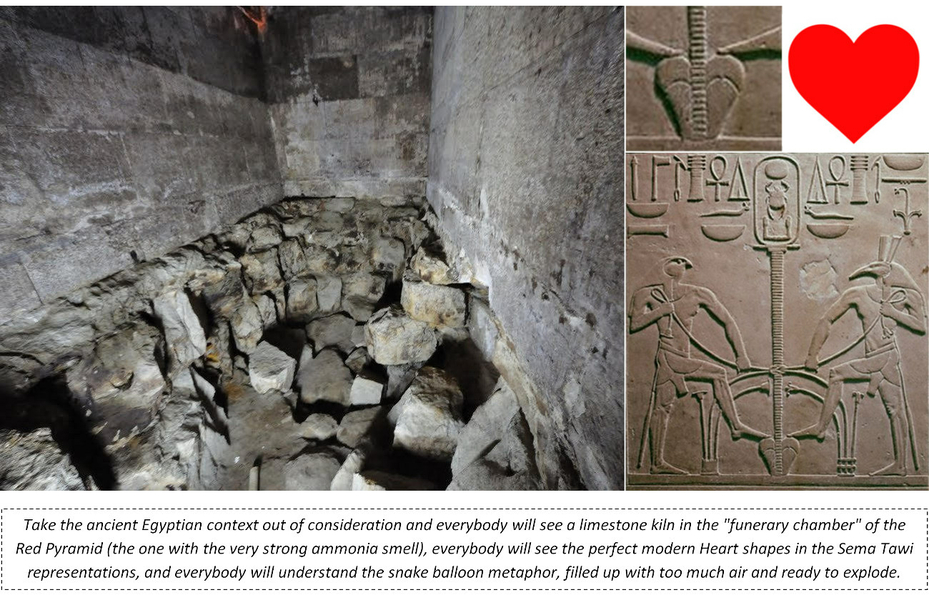
27.55 Everything about ancient Egyptian "art" and "religion" is entirely metaphoric
I guess that we've all been collectively "conditioned" not to think anymore regarding ancient Egypt; because if you take the "ancient Egyptian" context out of consideration, everybody will see a limestone kiln in what is called the "funerary chamber" of the Red Pyramid; everybody will see perfect heart shape representation in the "sema tawy symbols" and everybody will see a snake balloon ready to explode on Sekhmet's head.
Poster un commentaire
